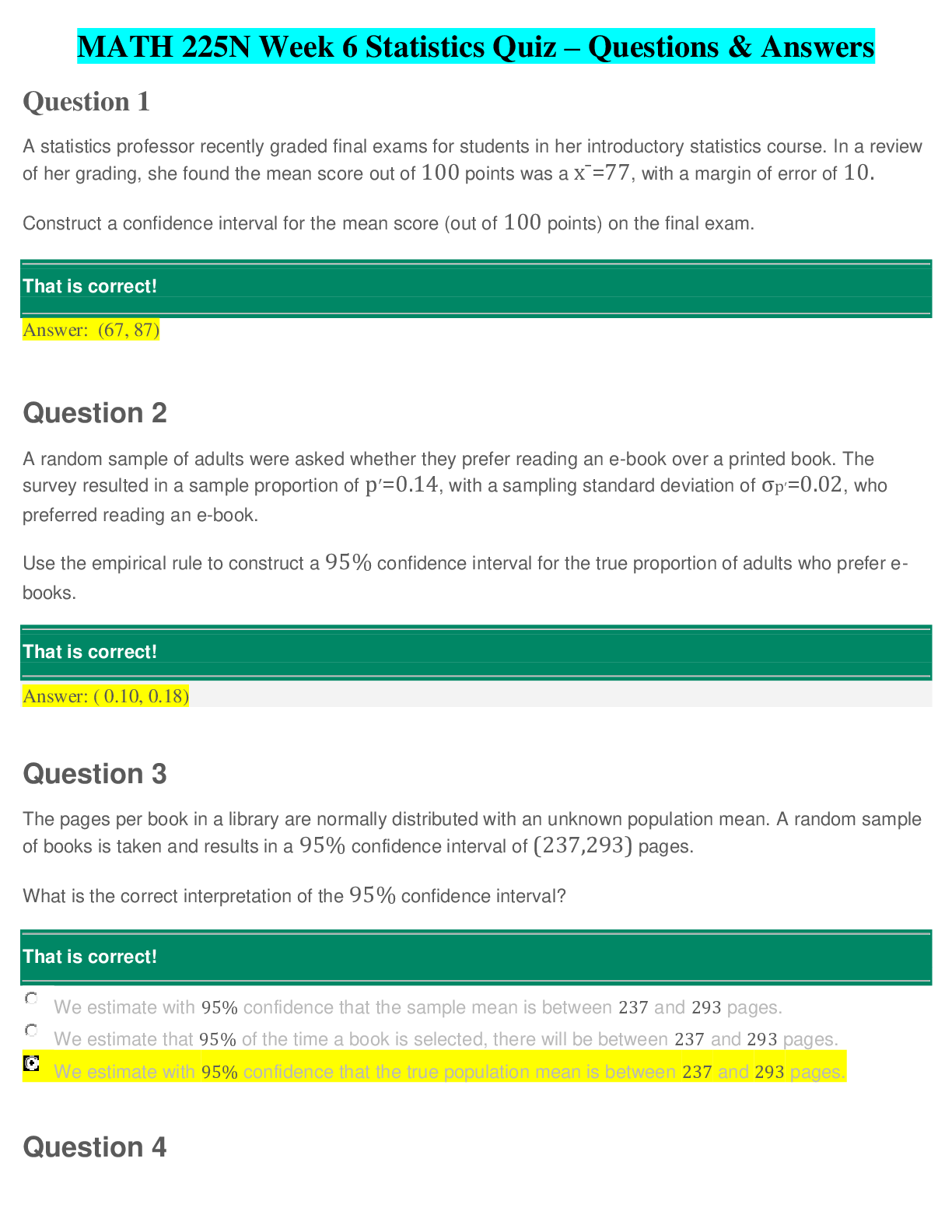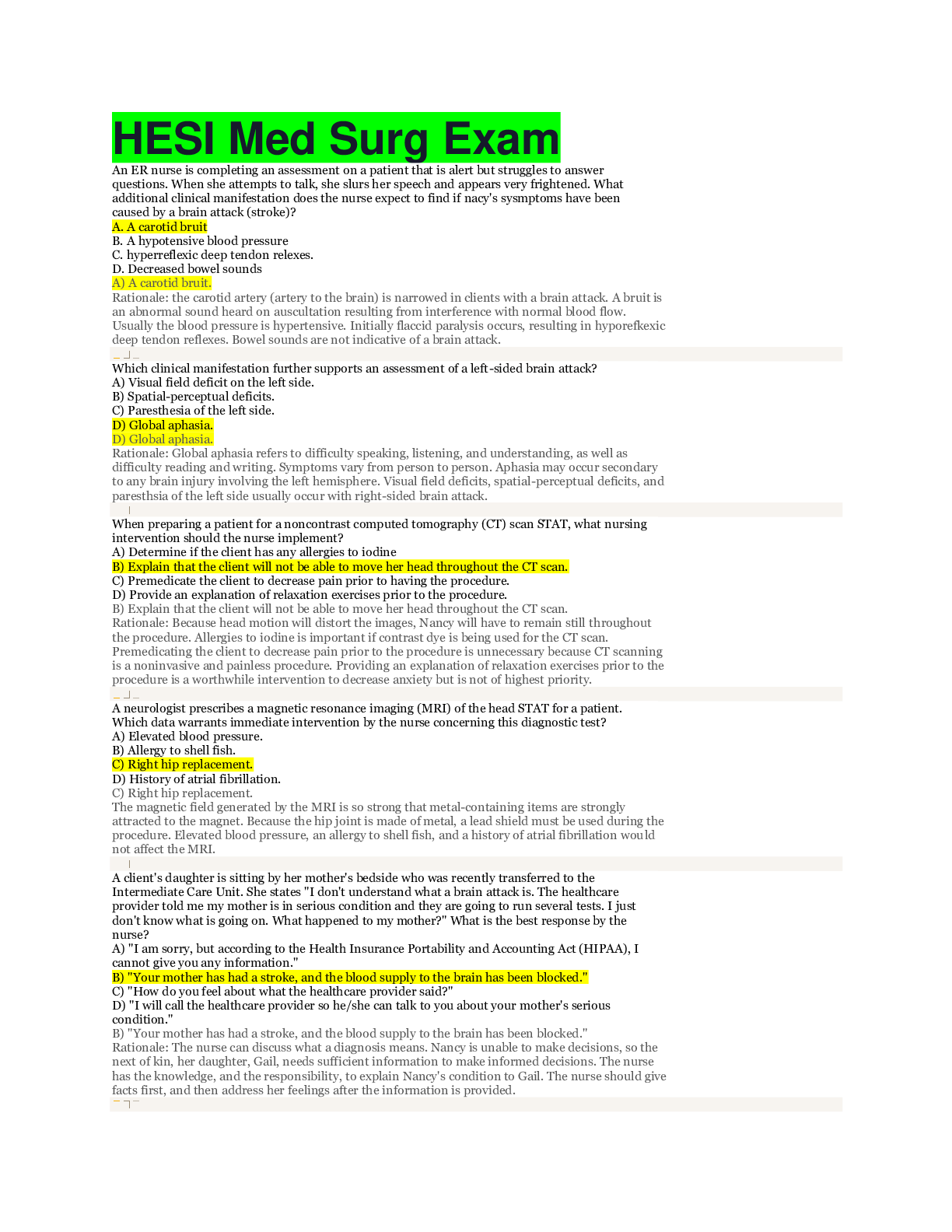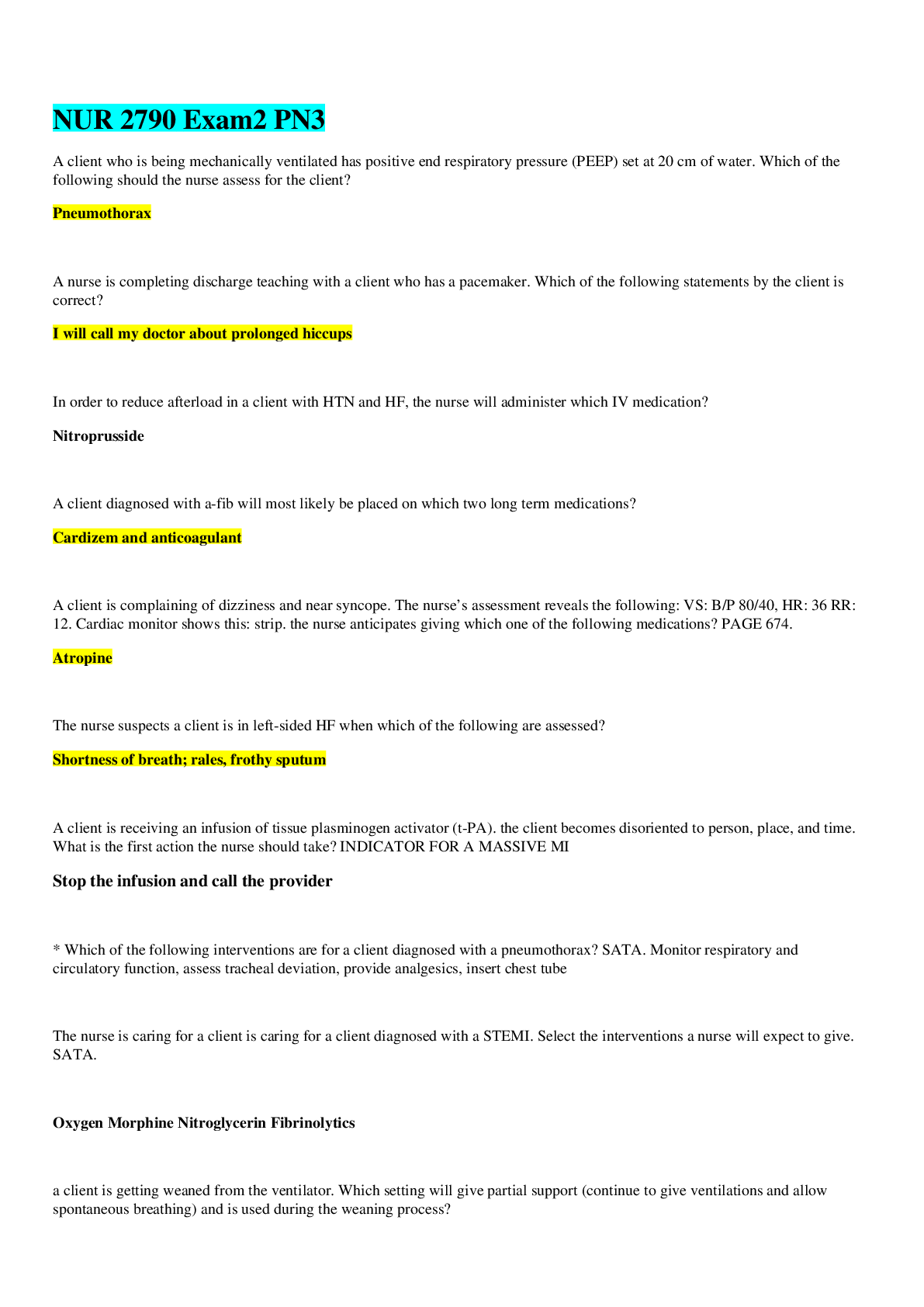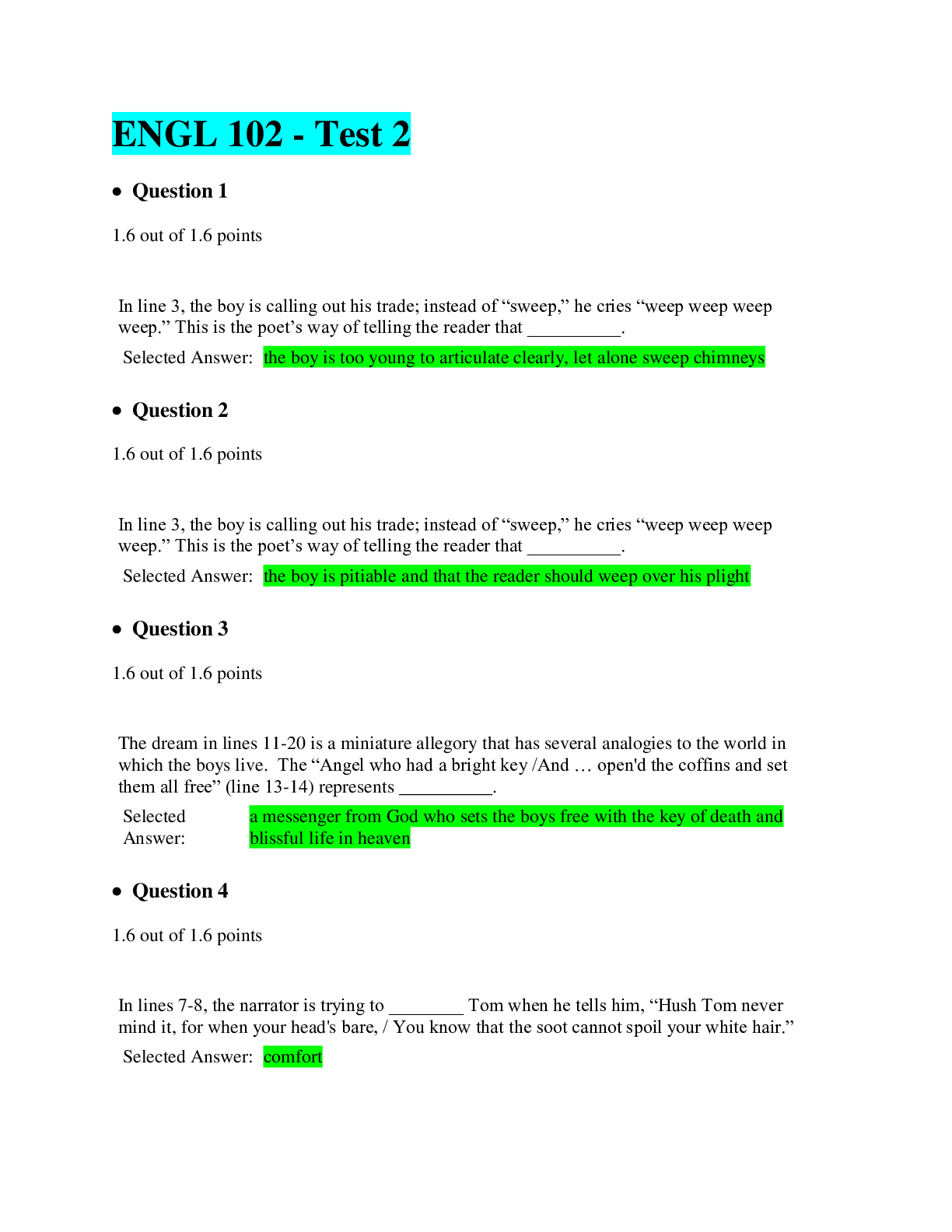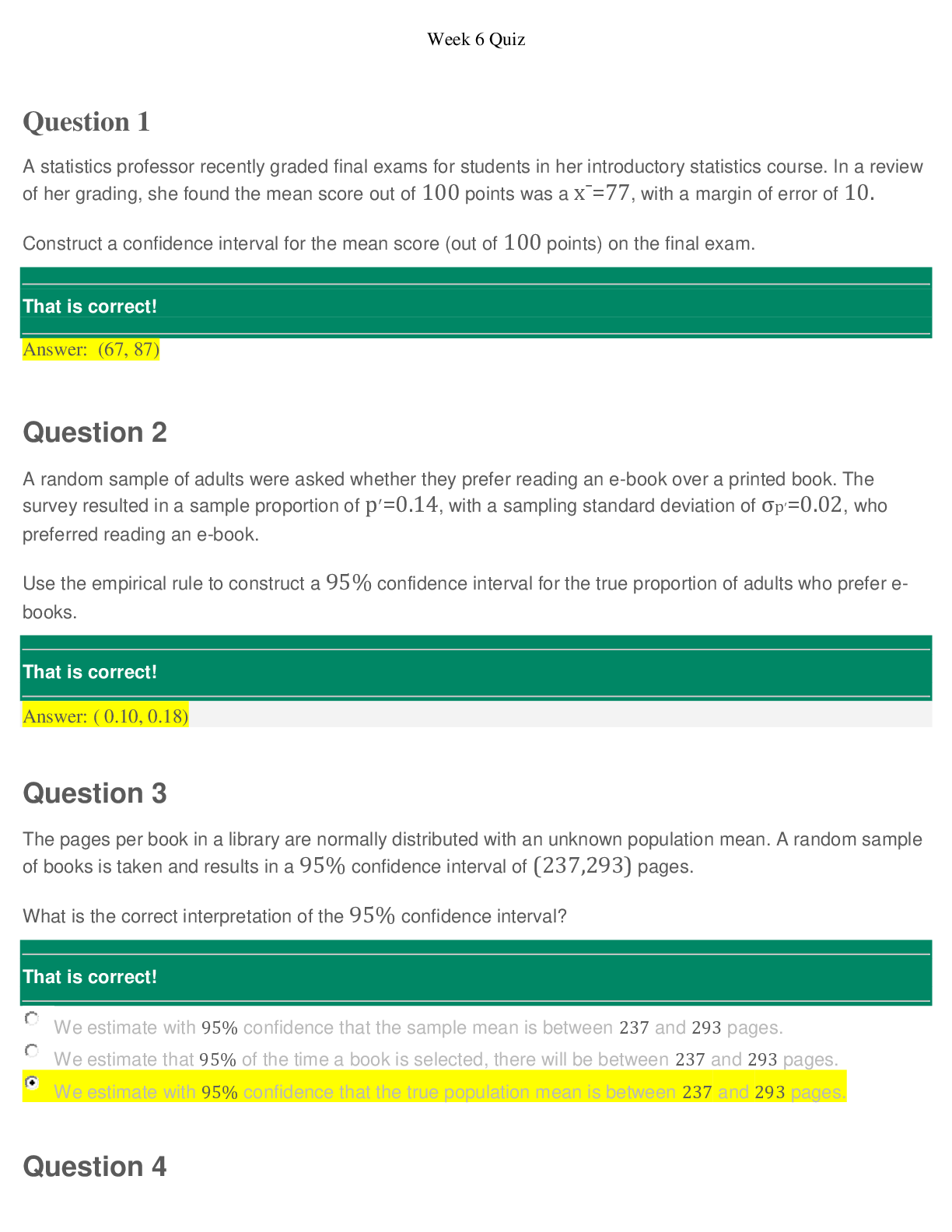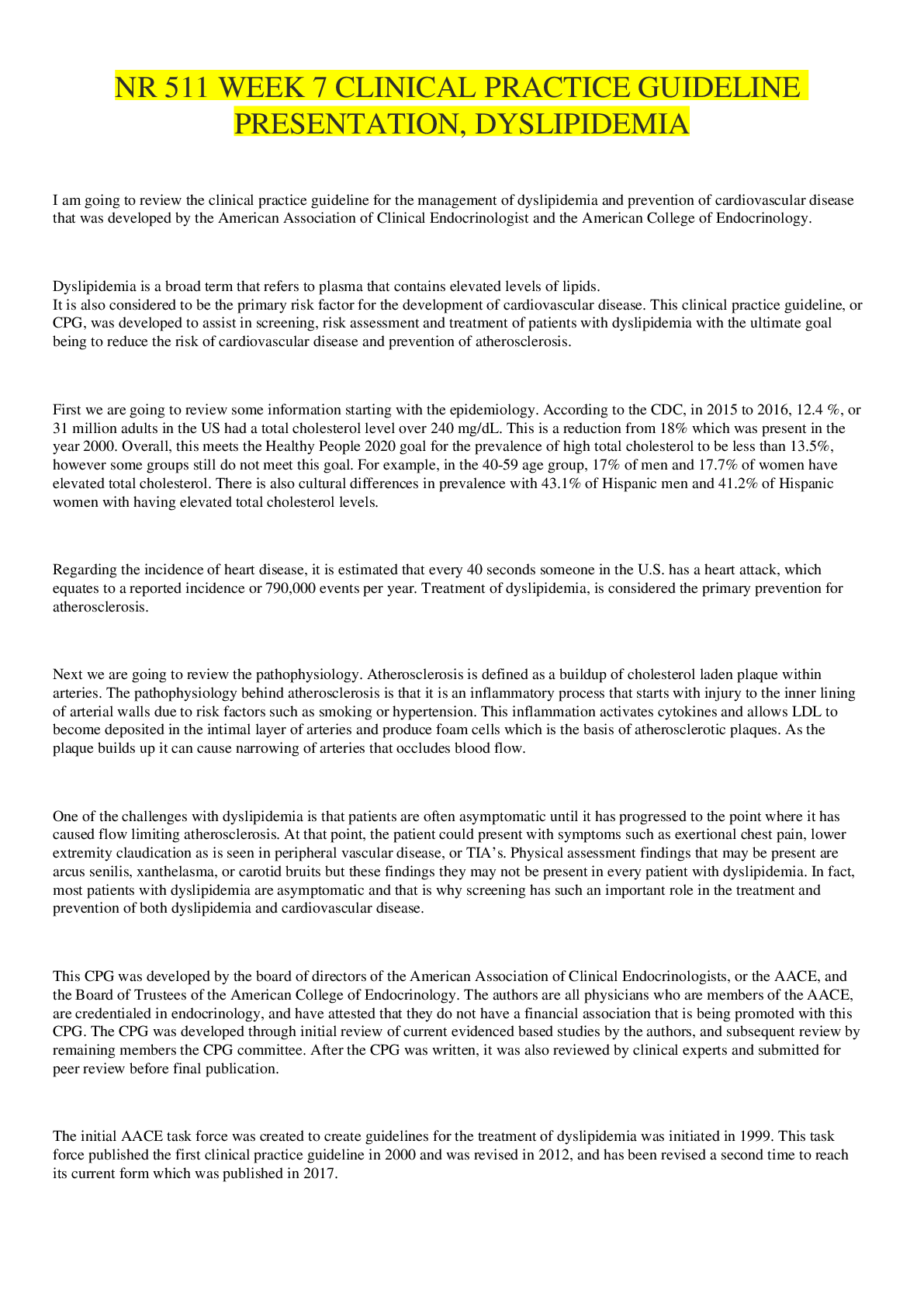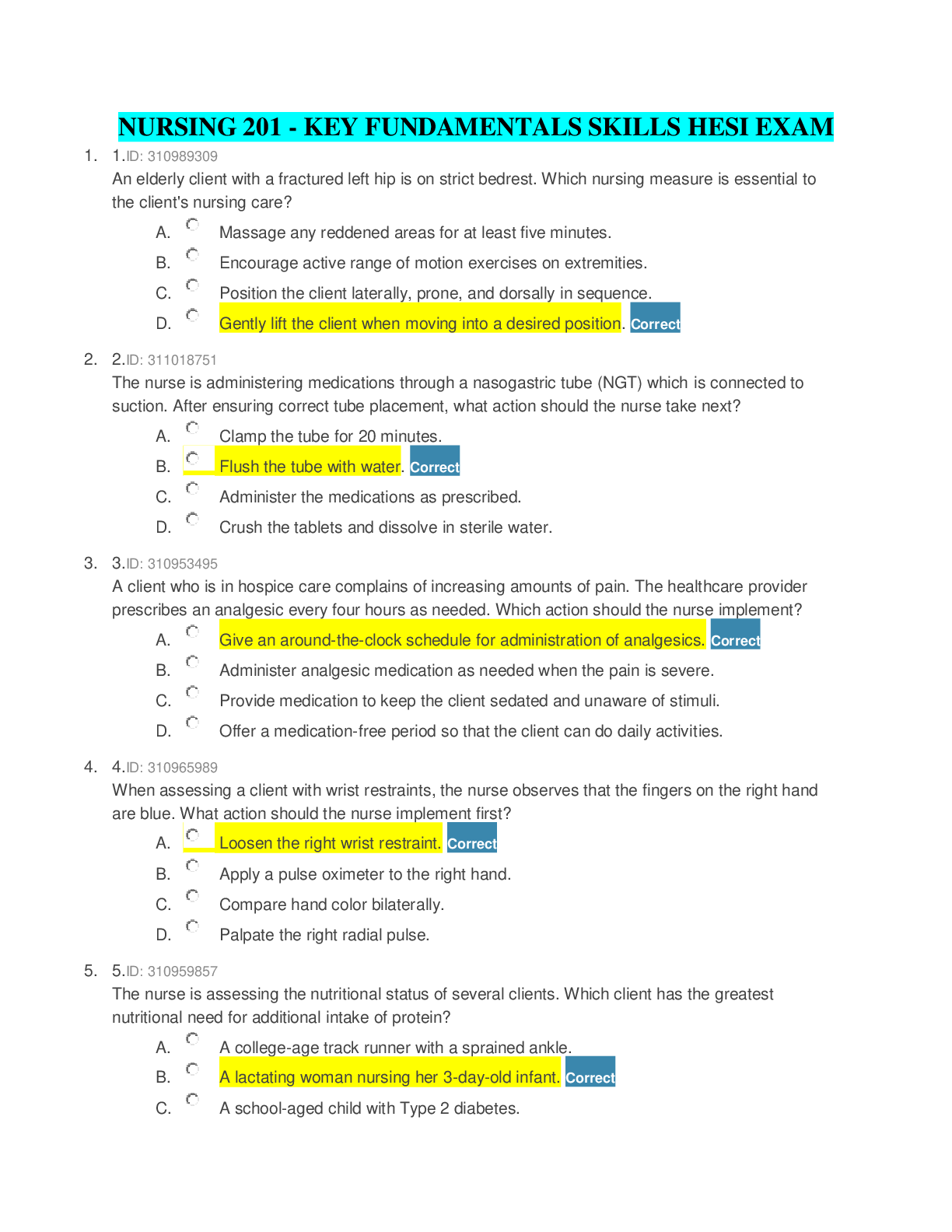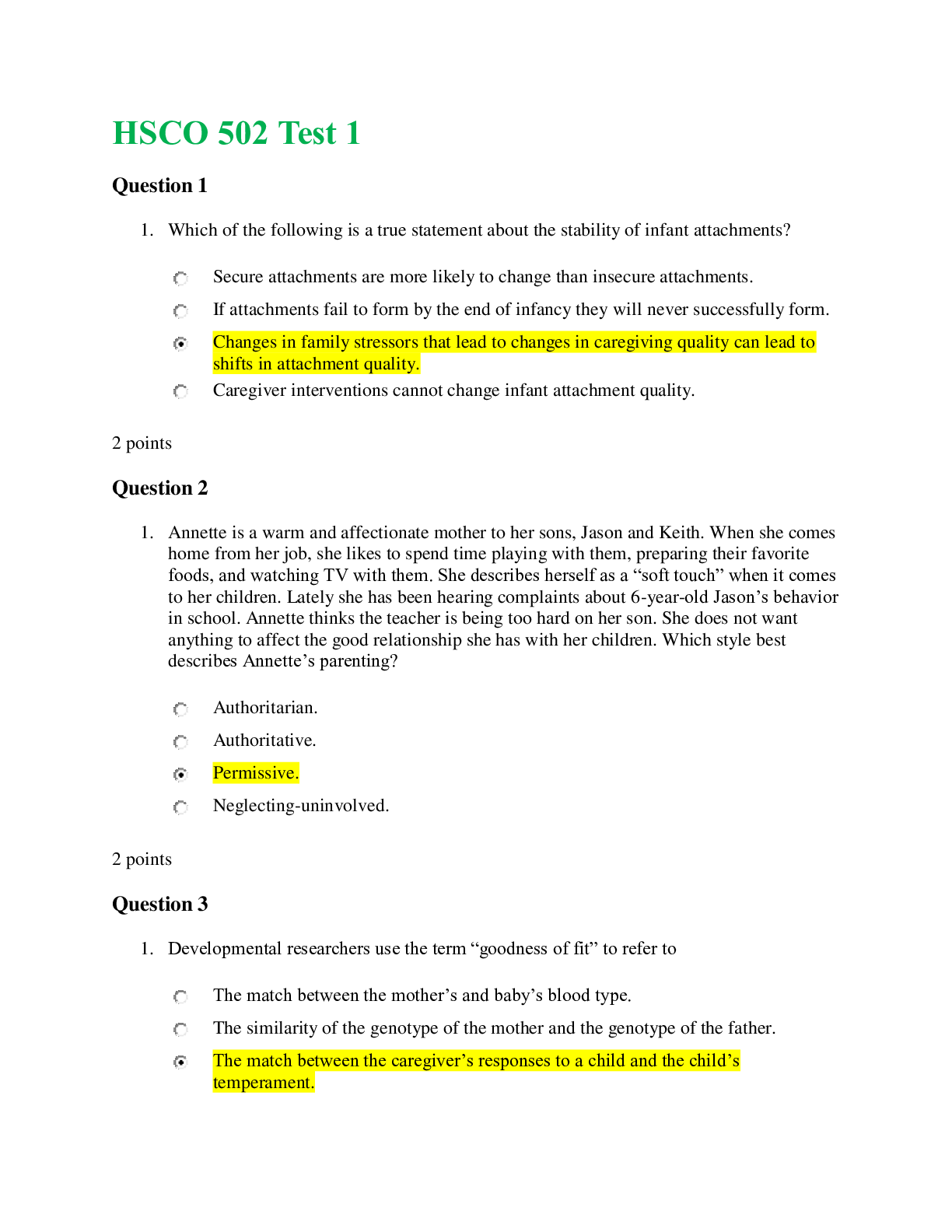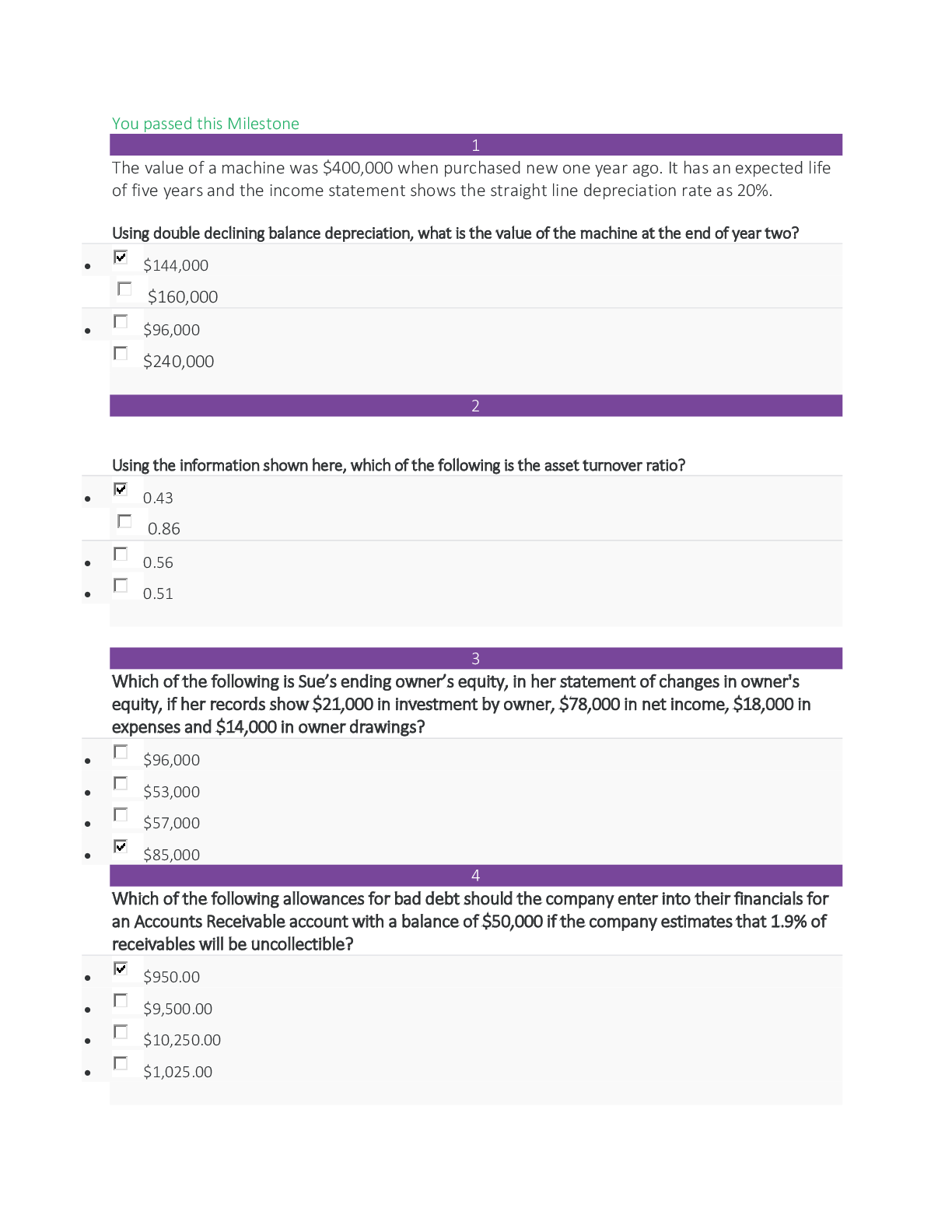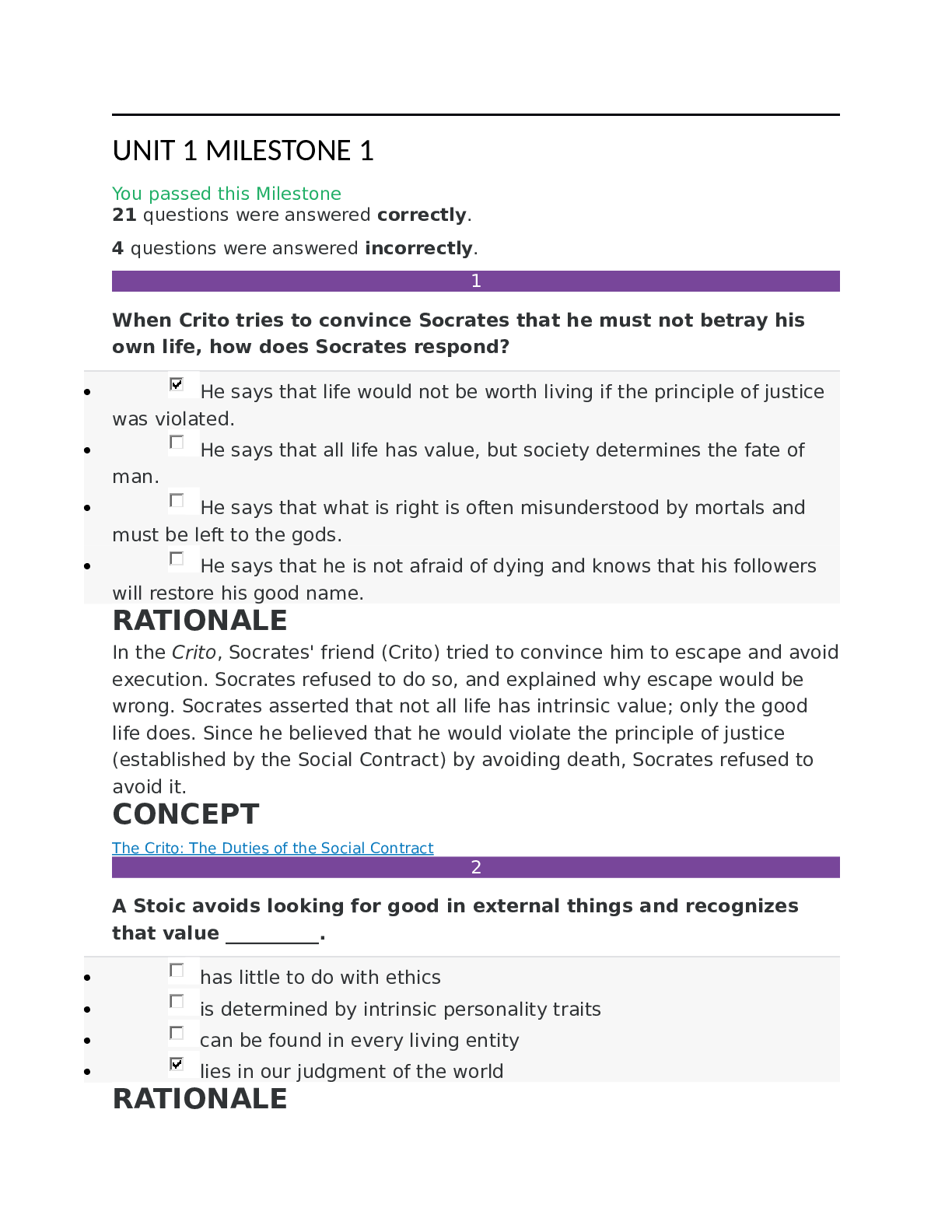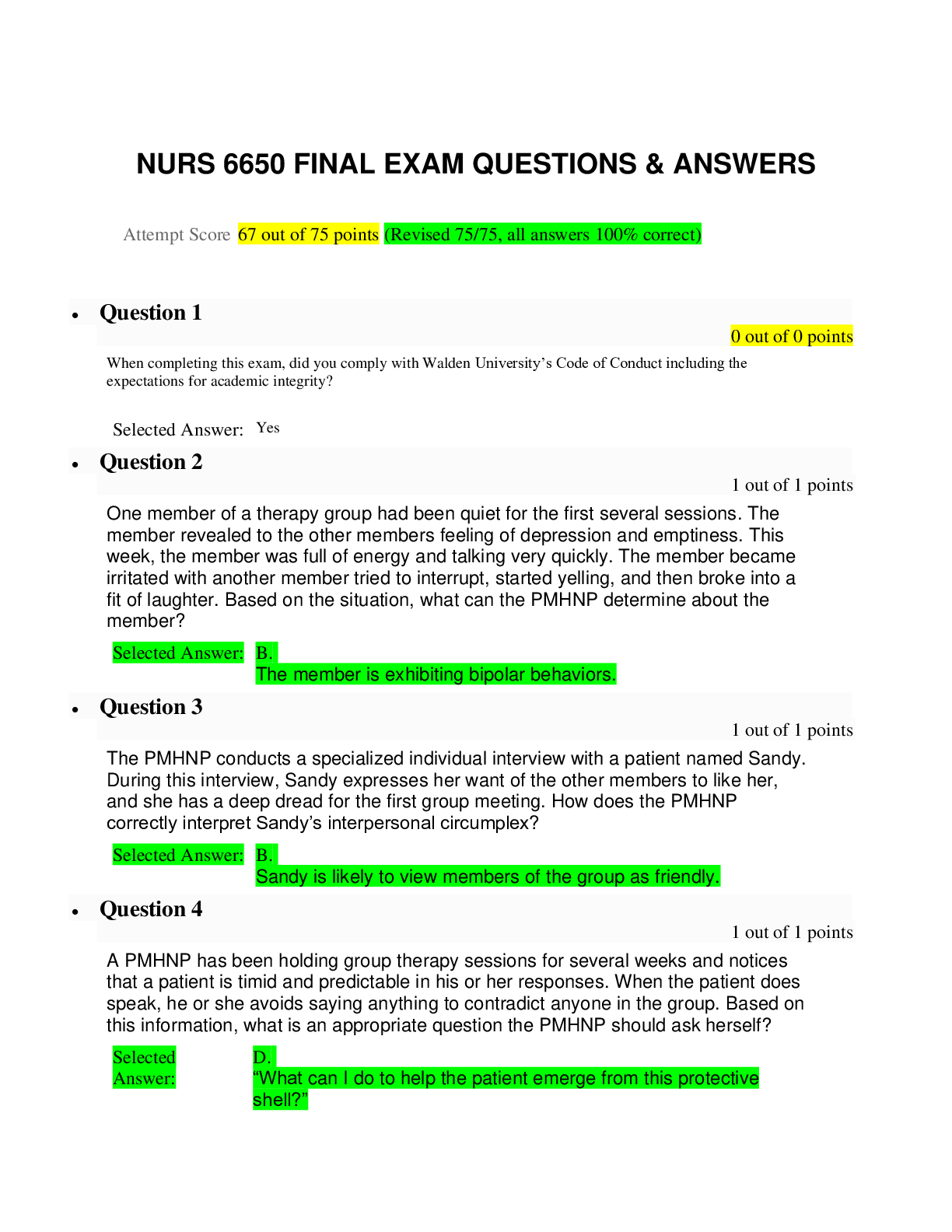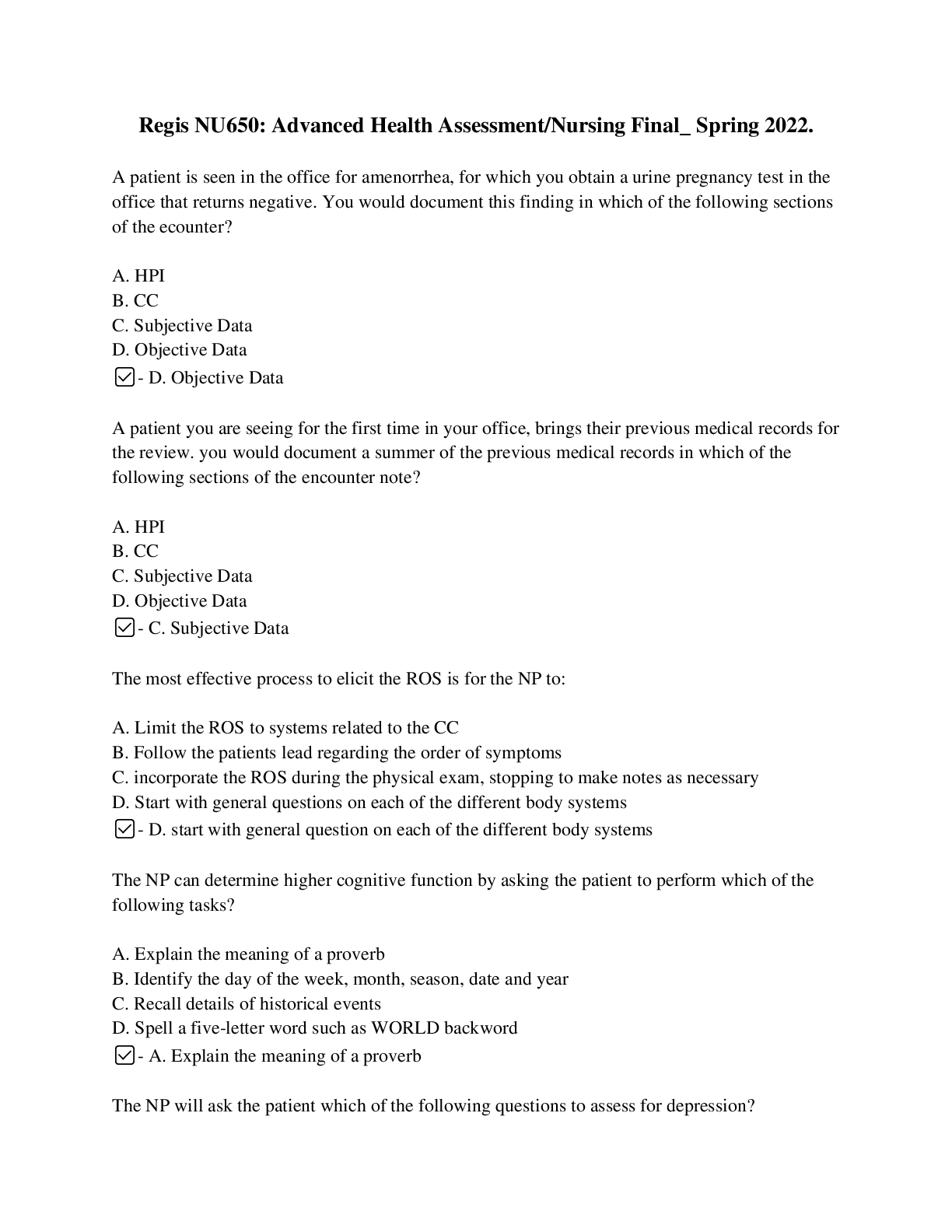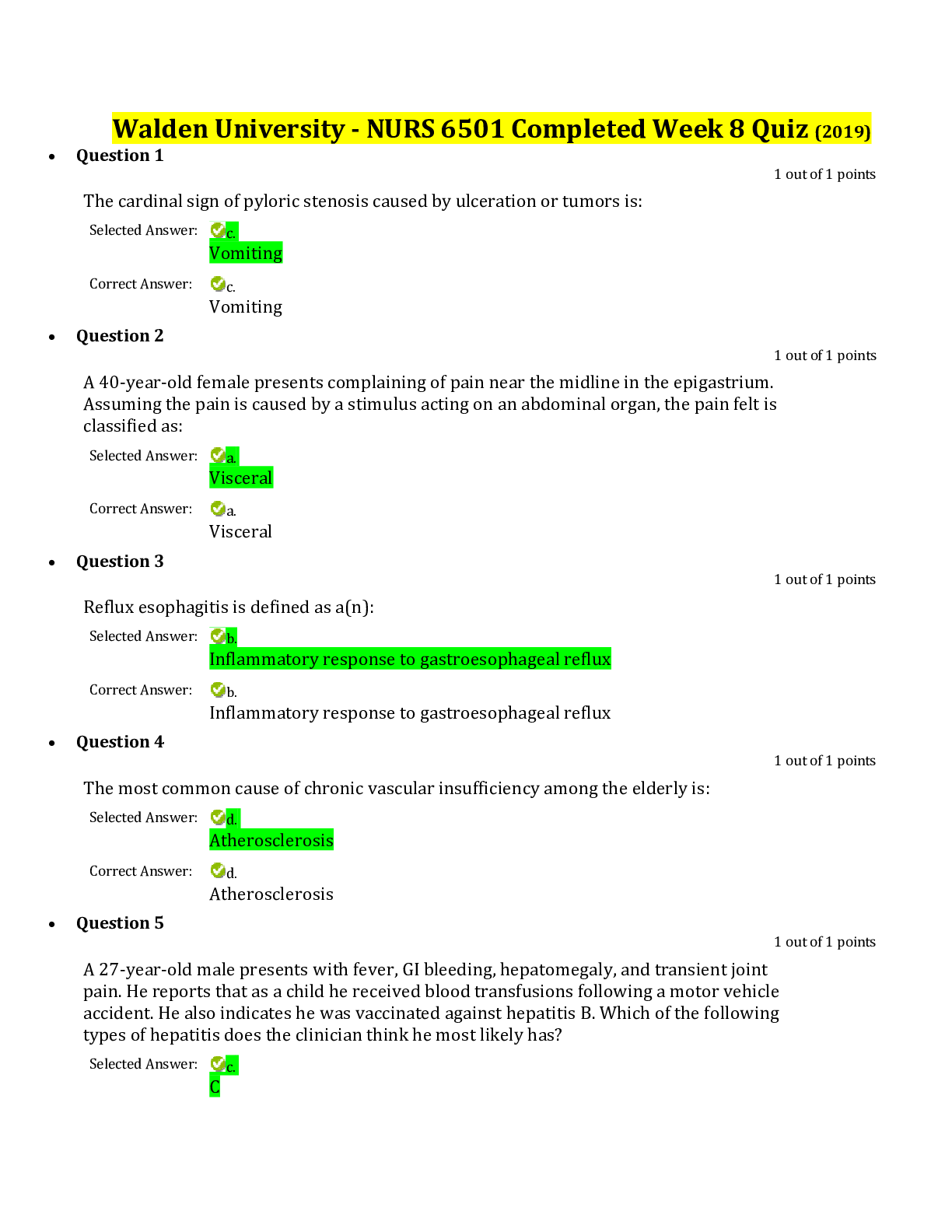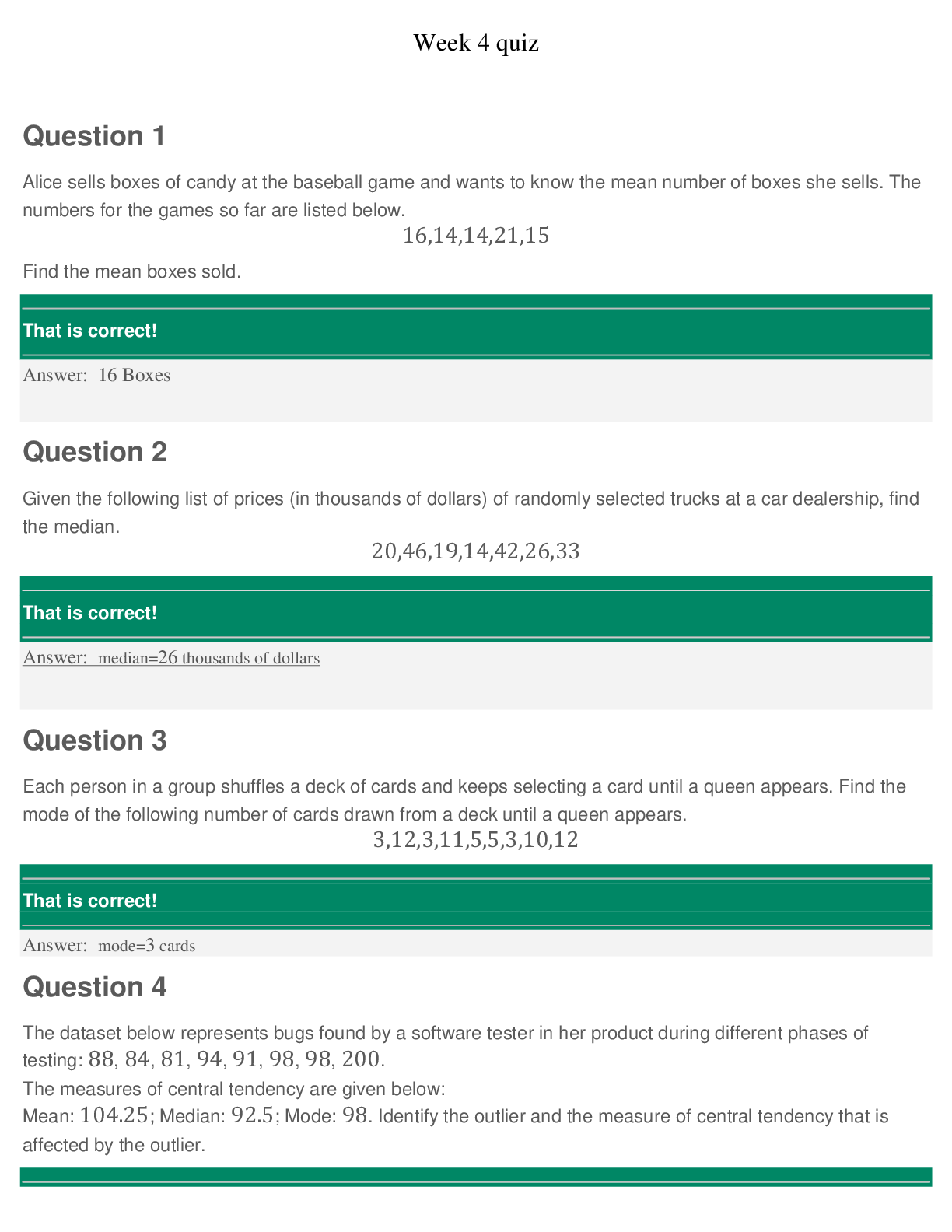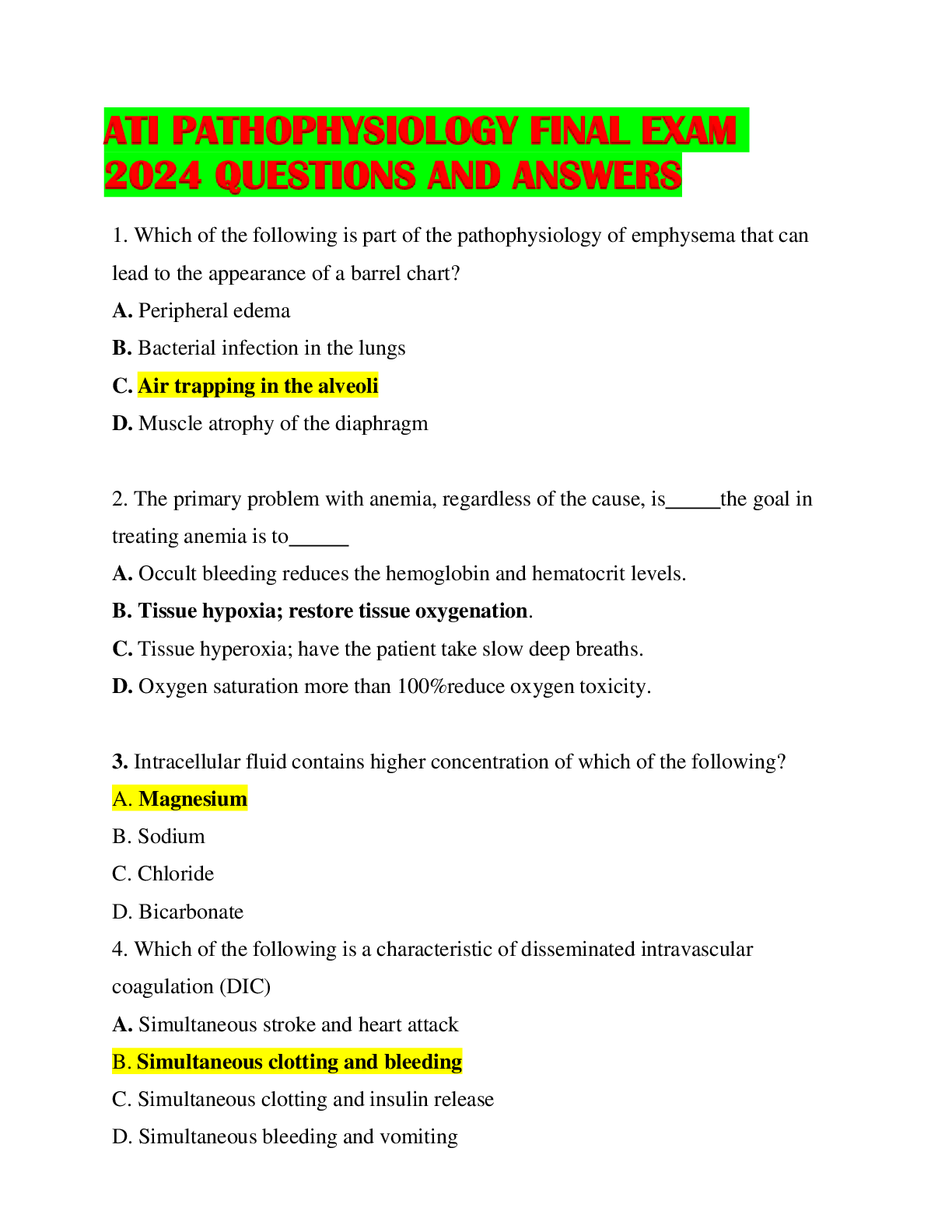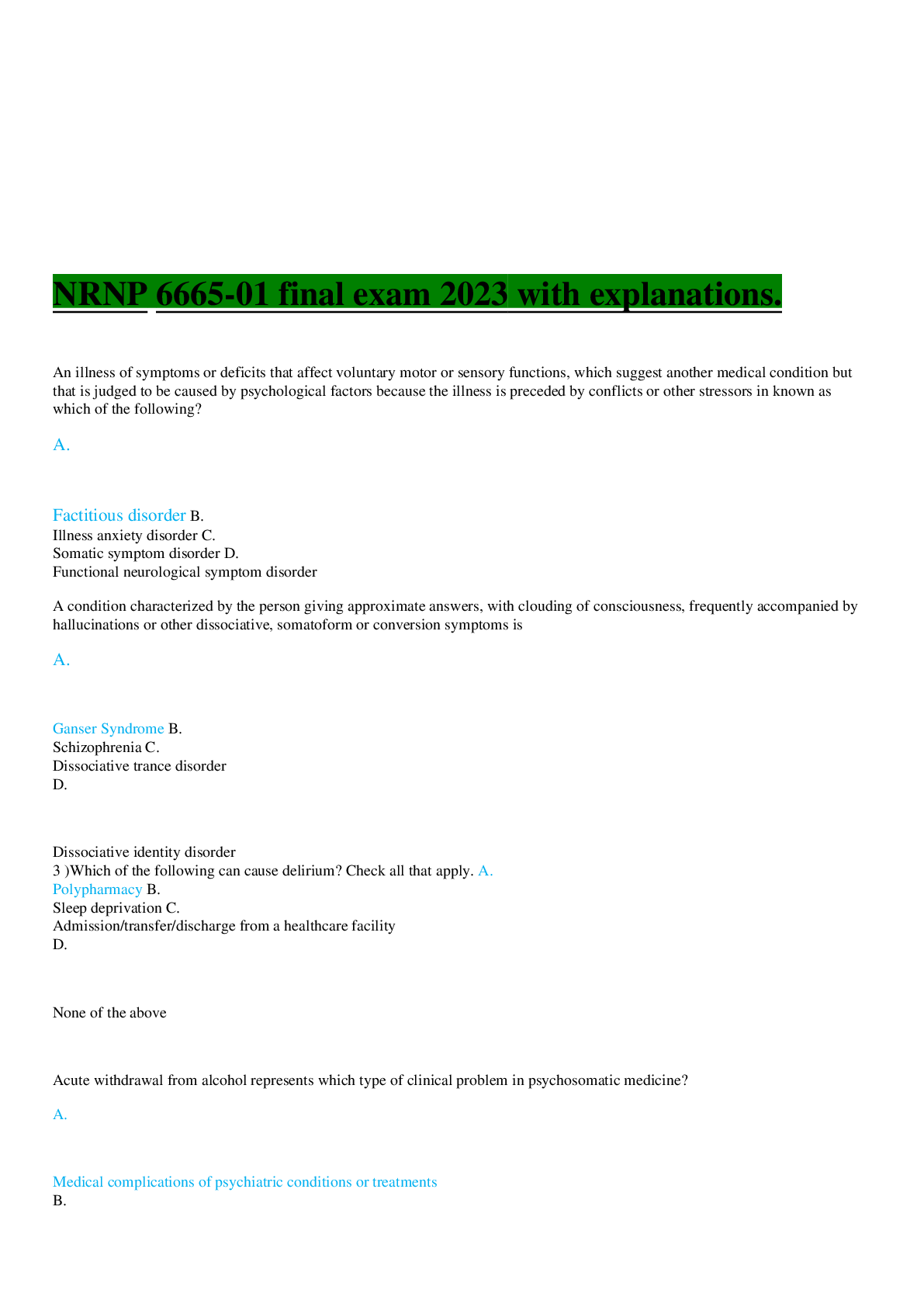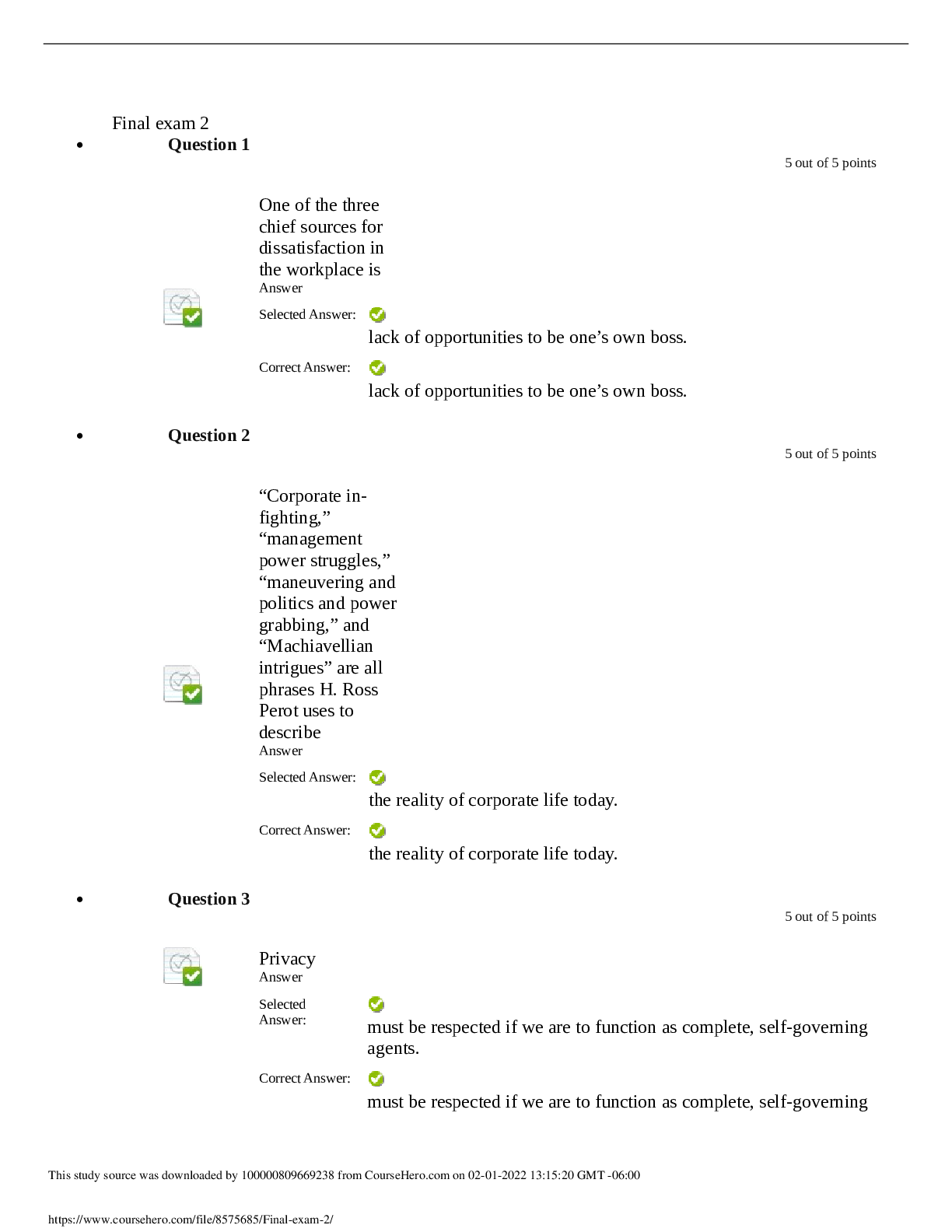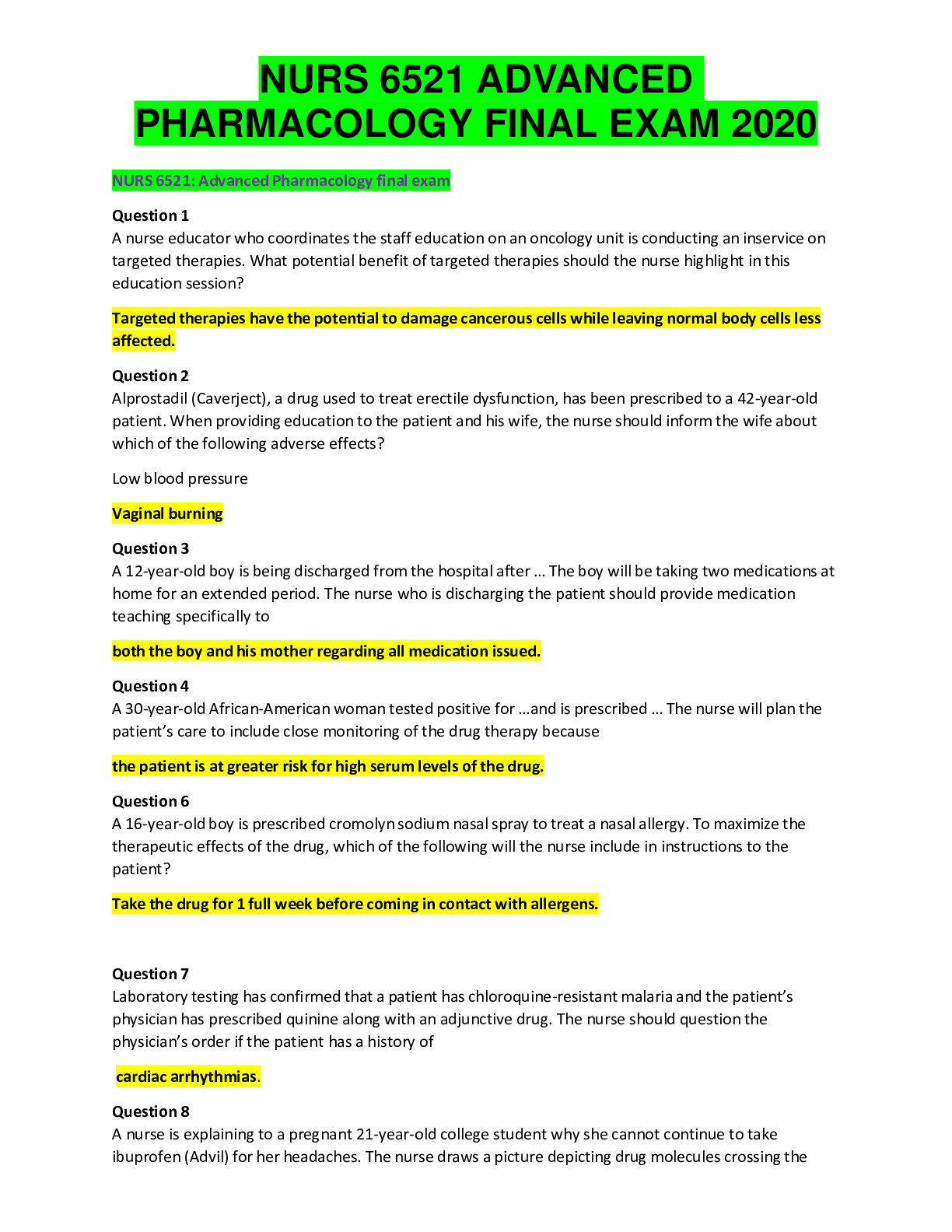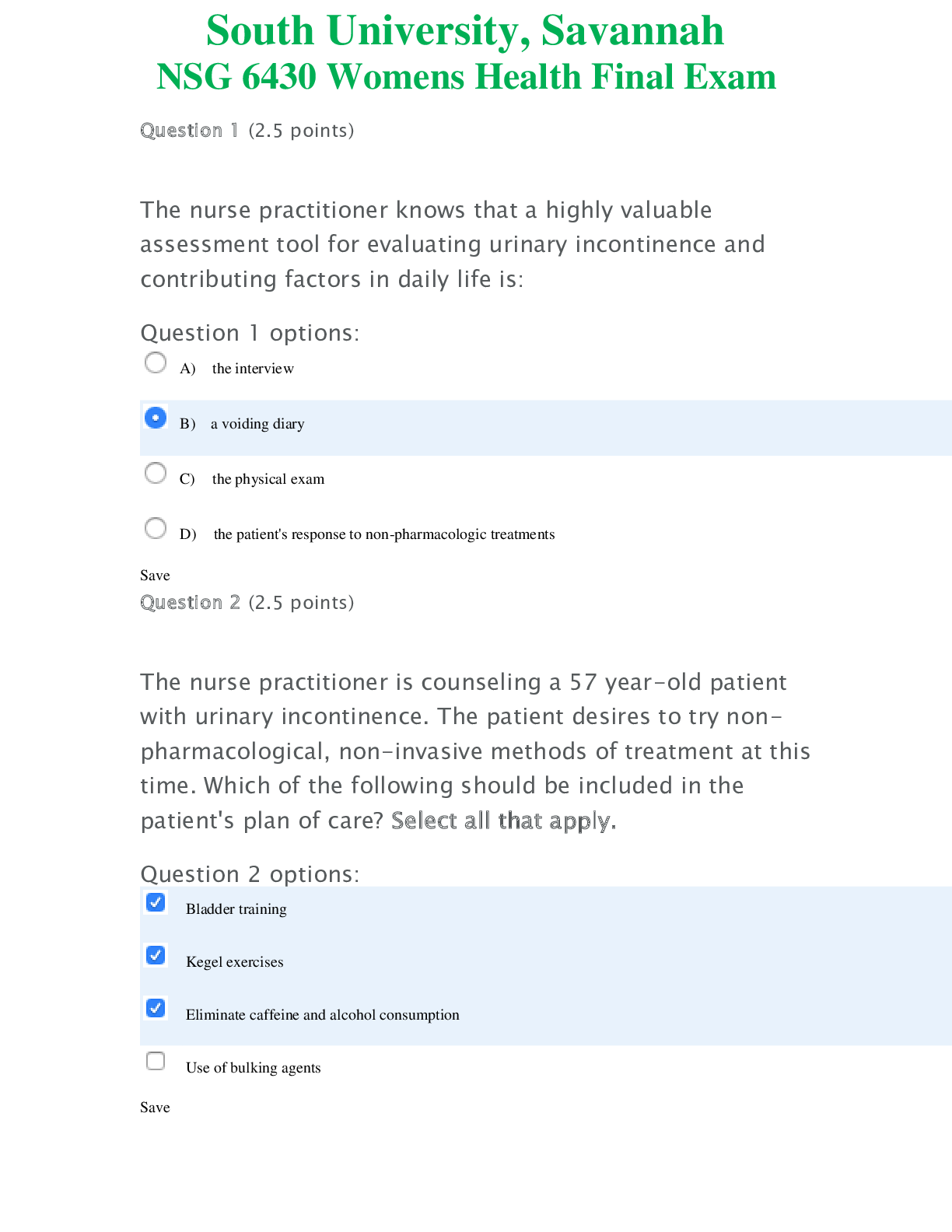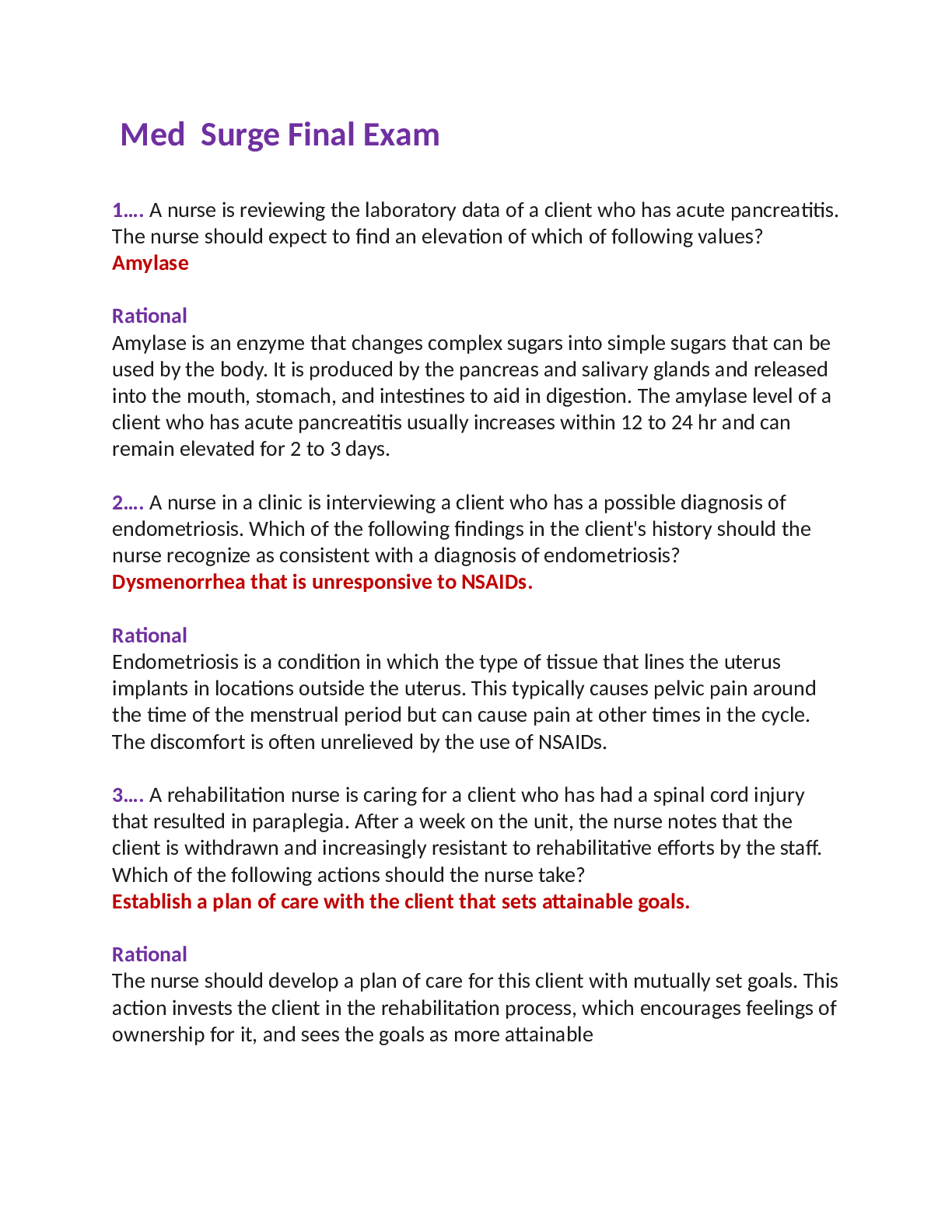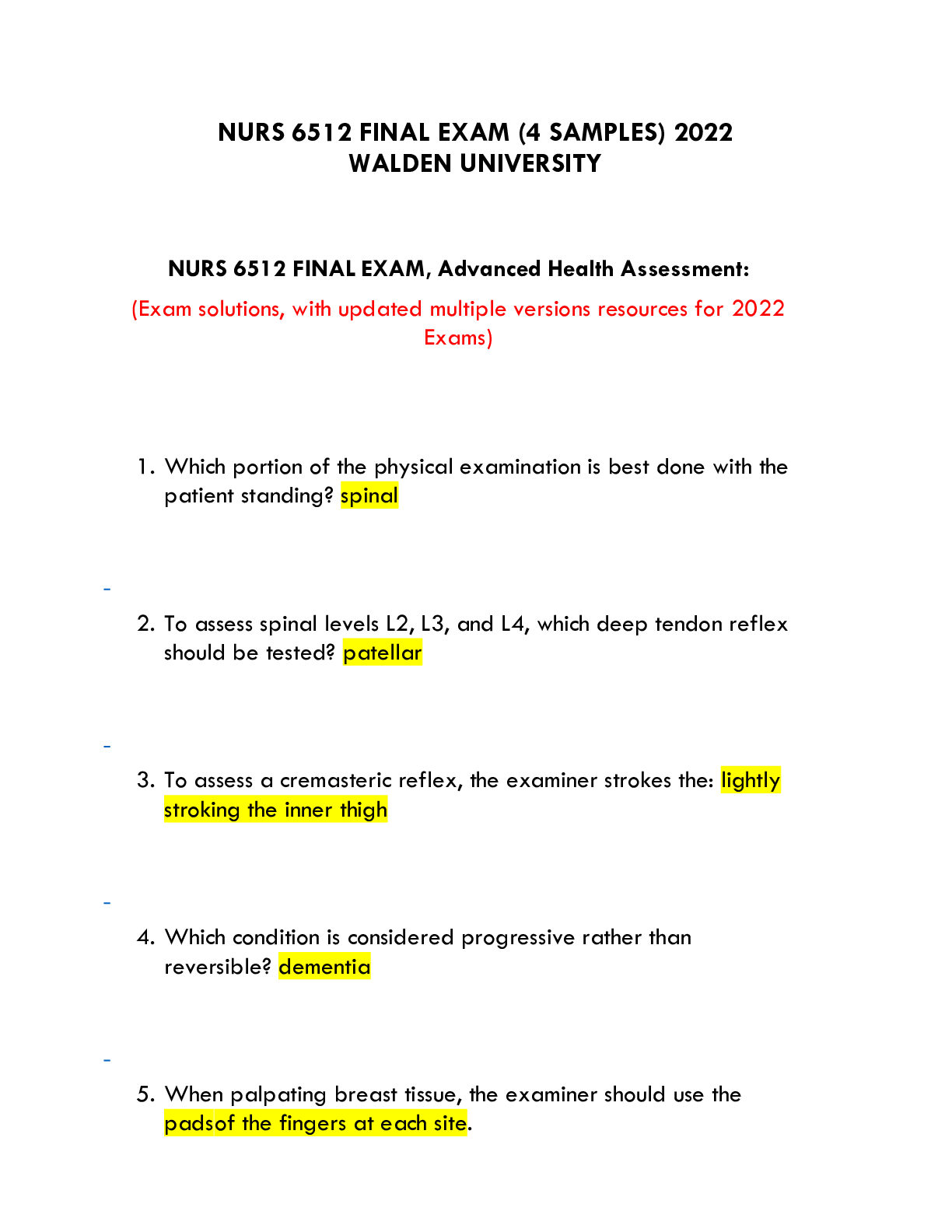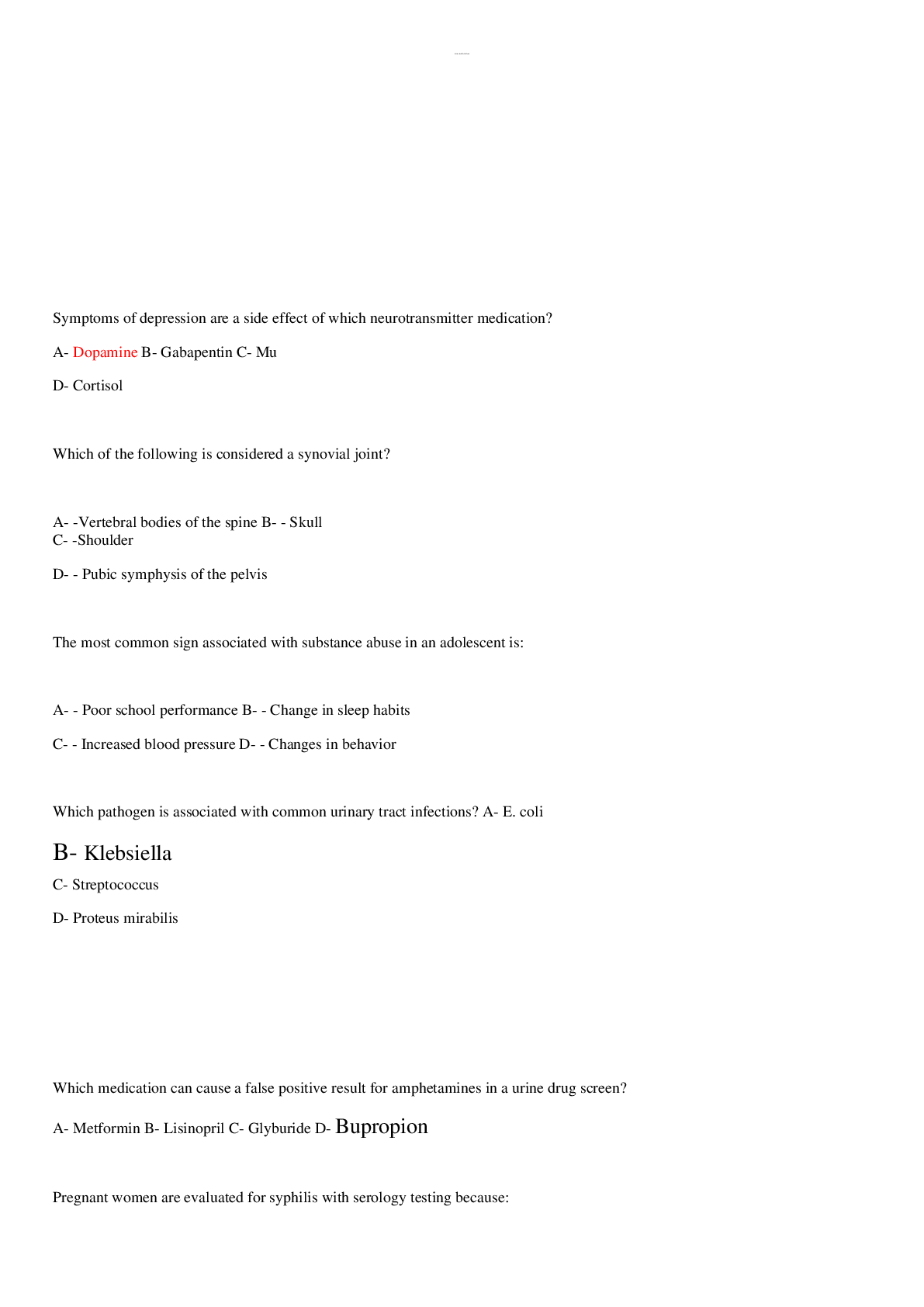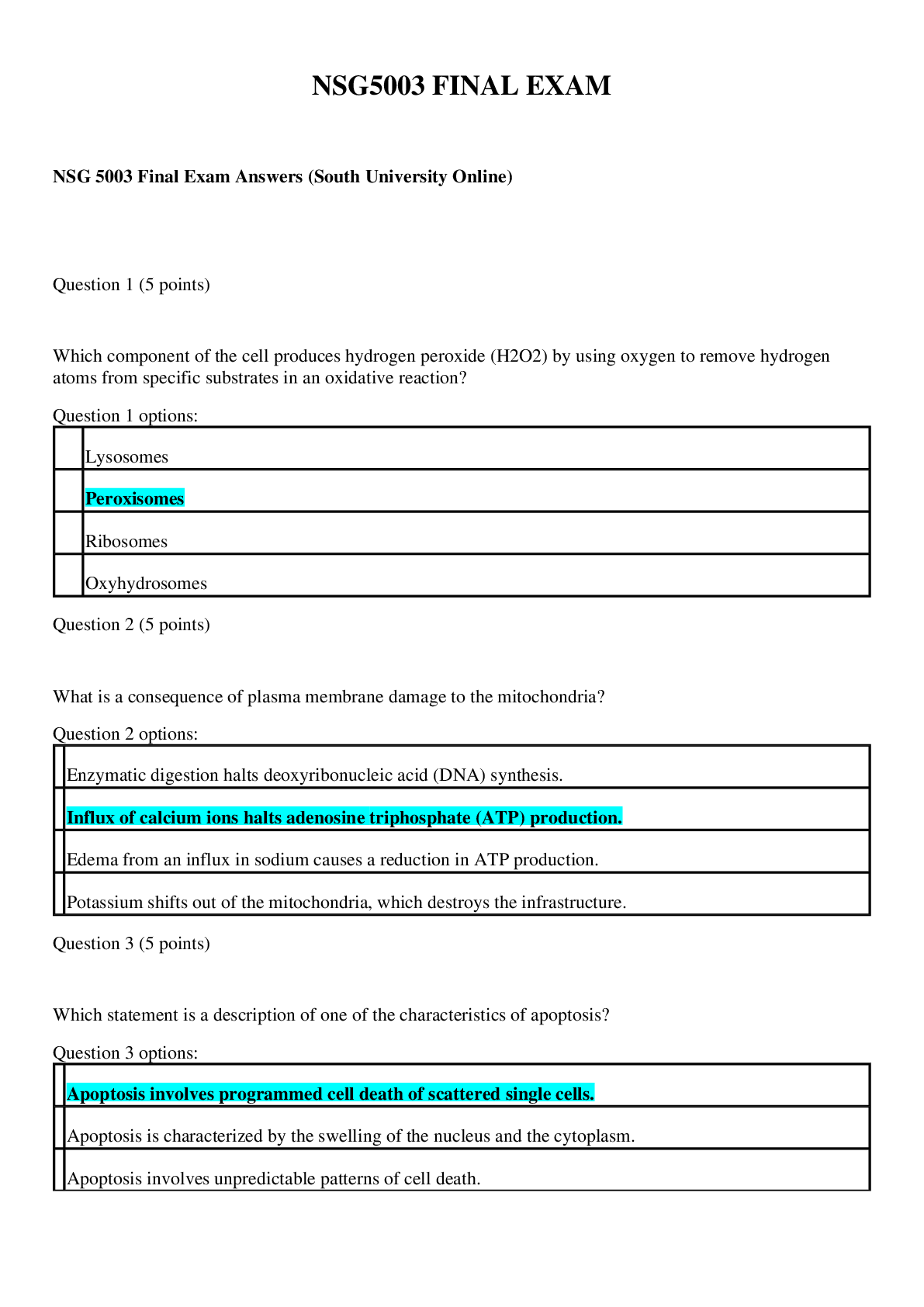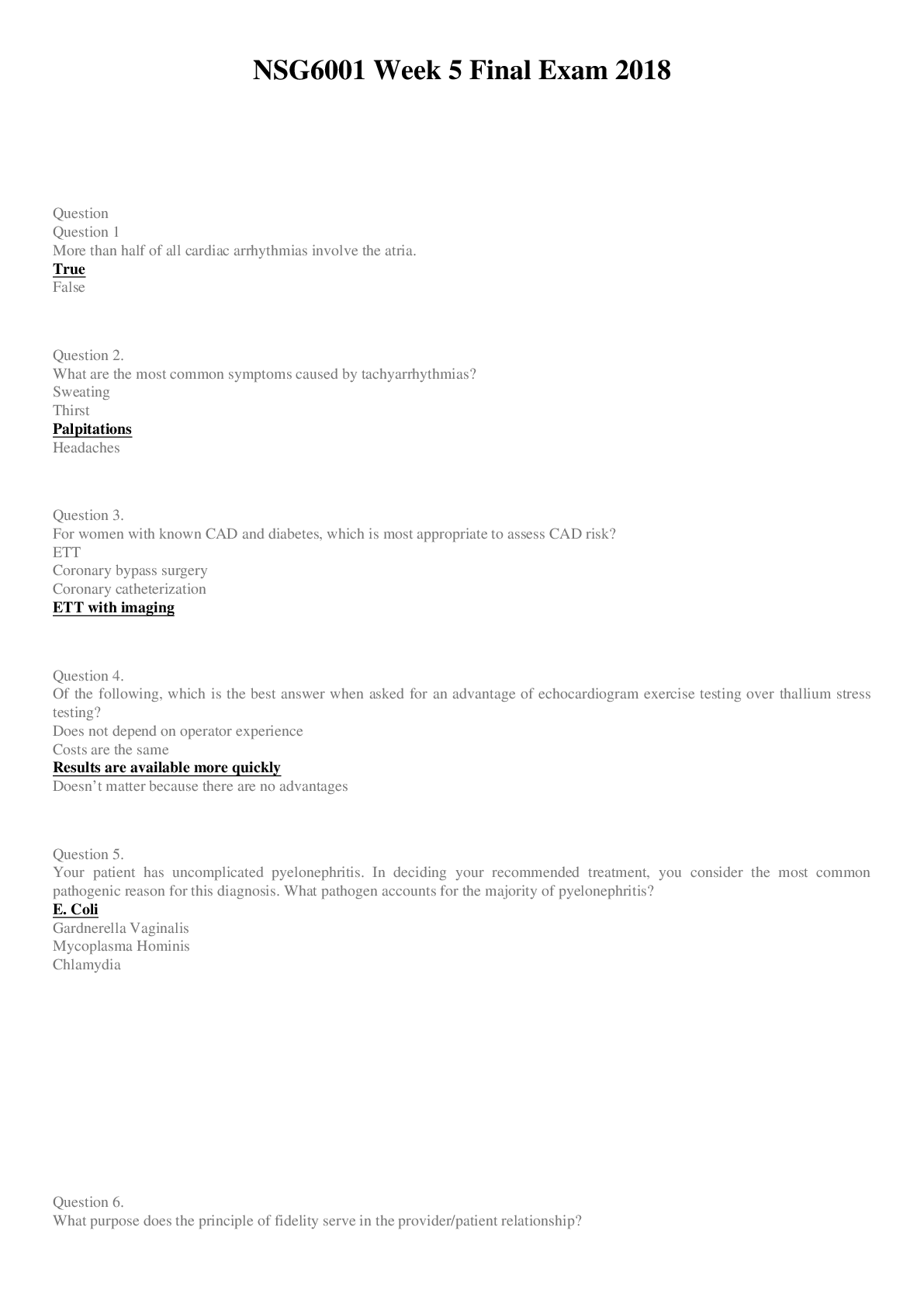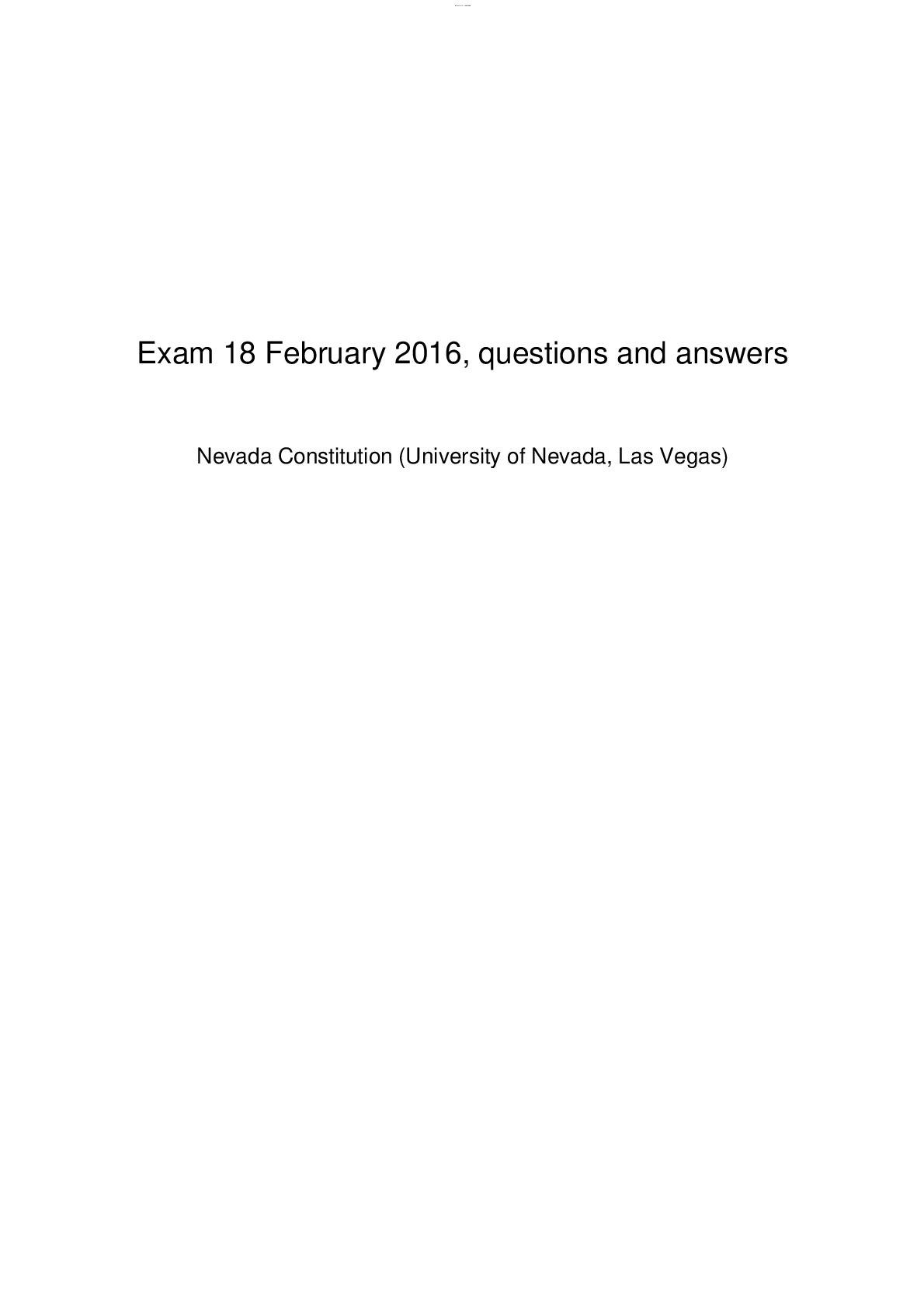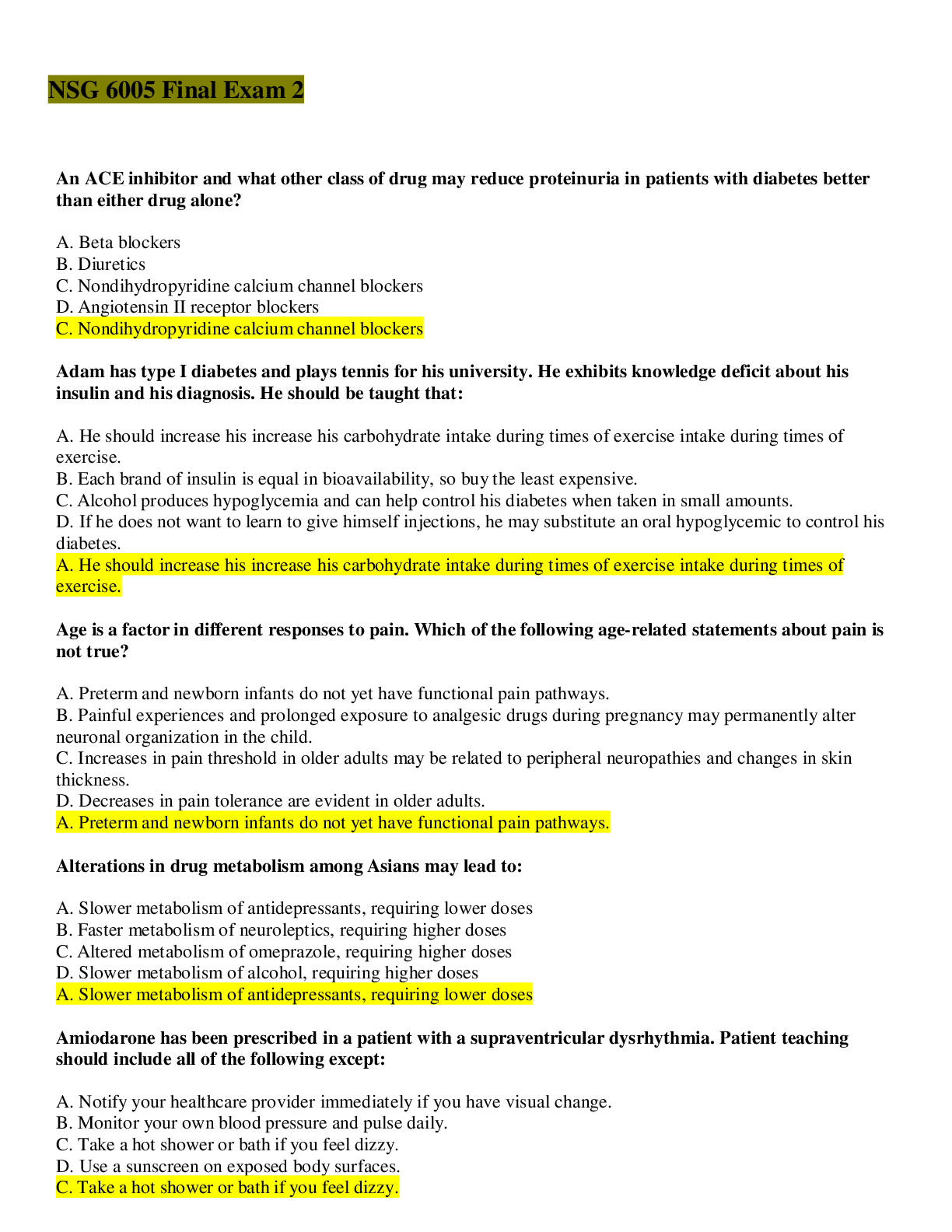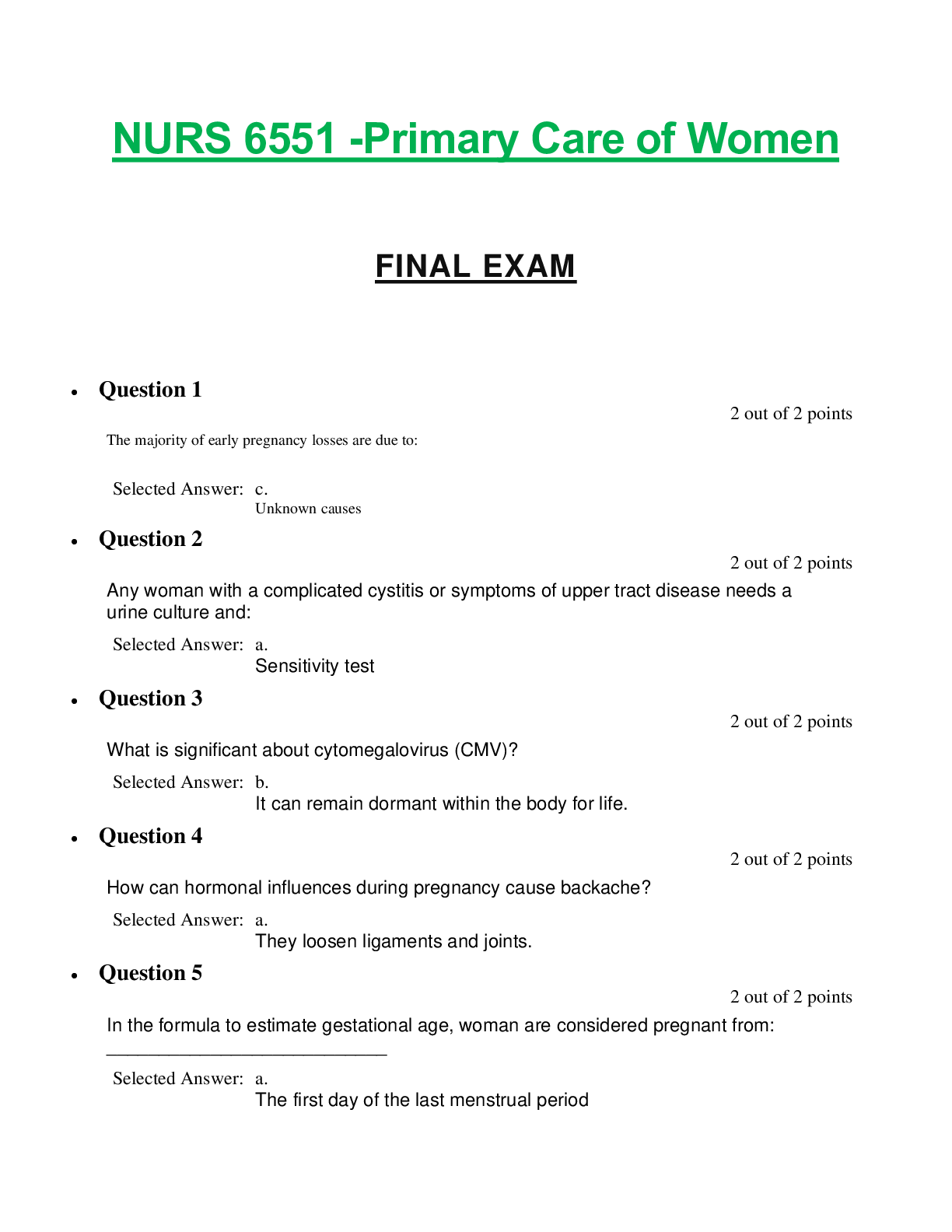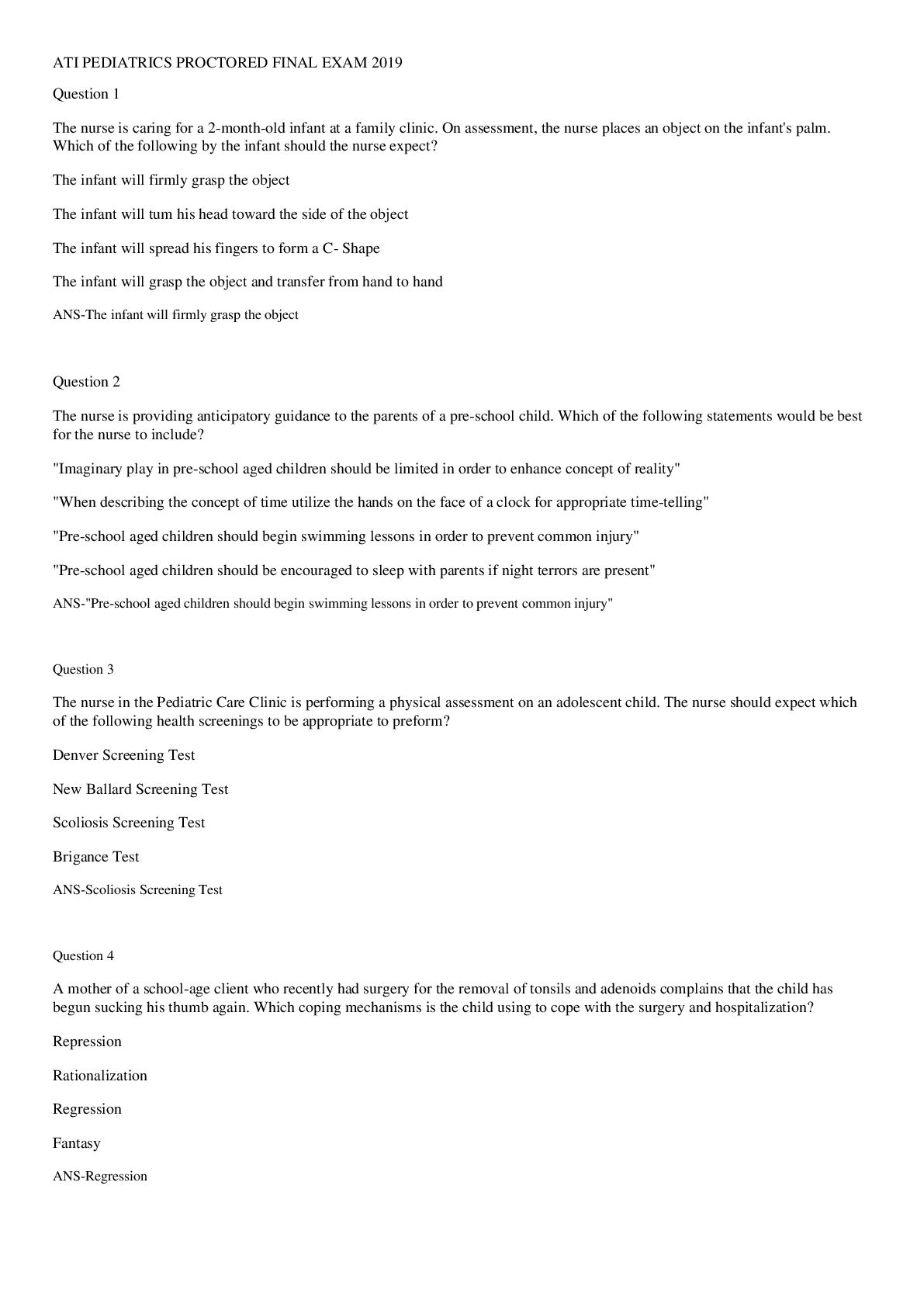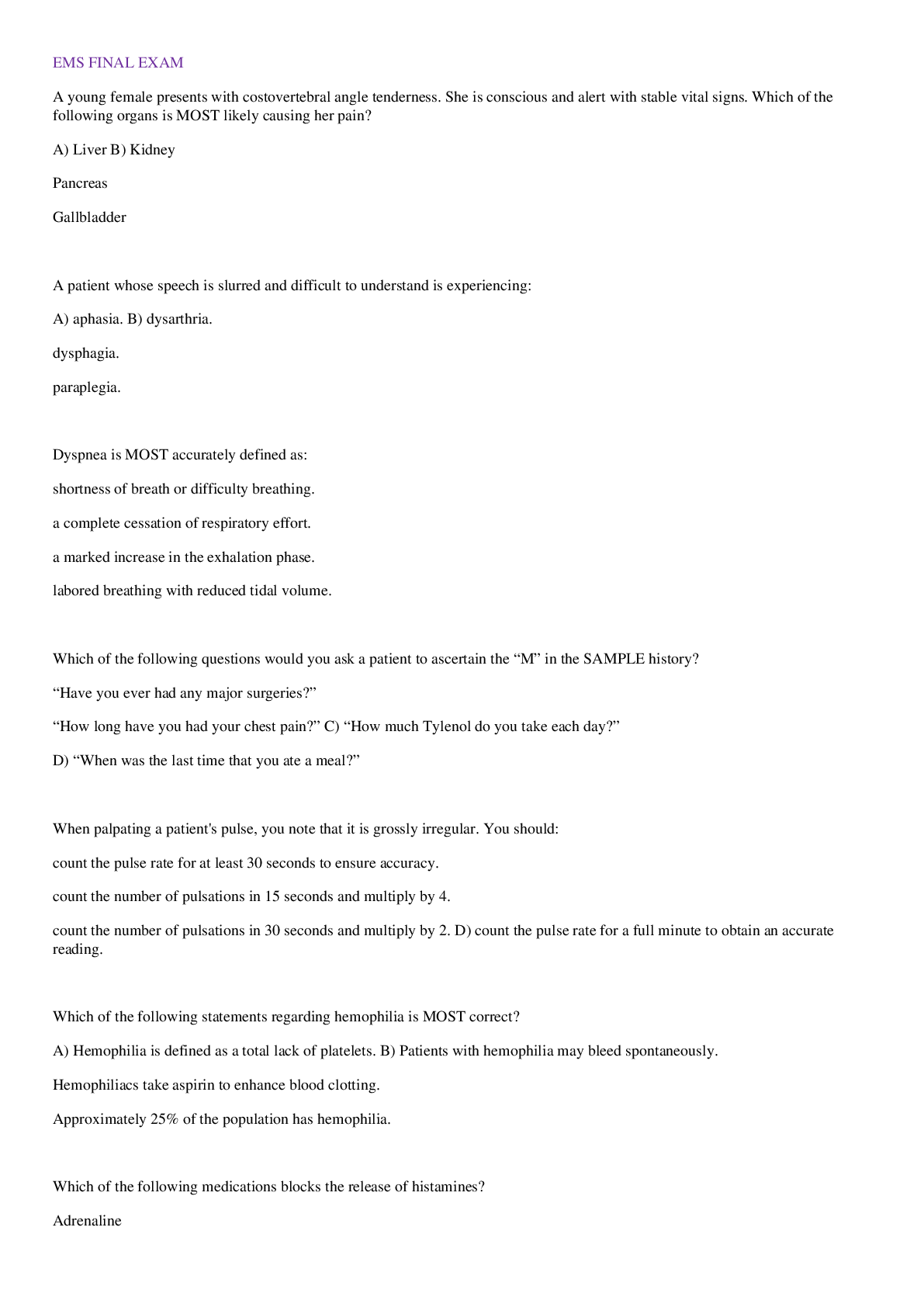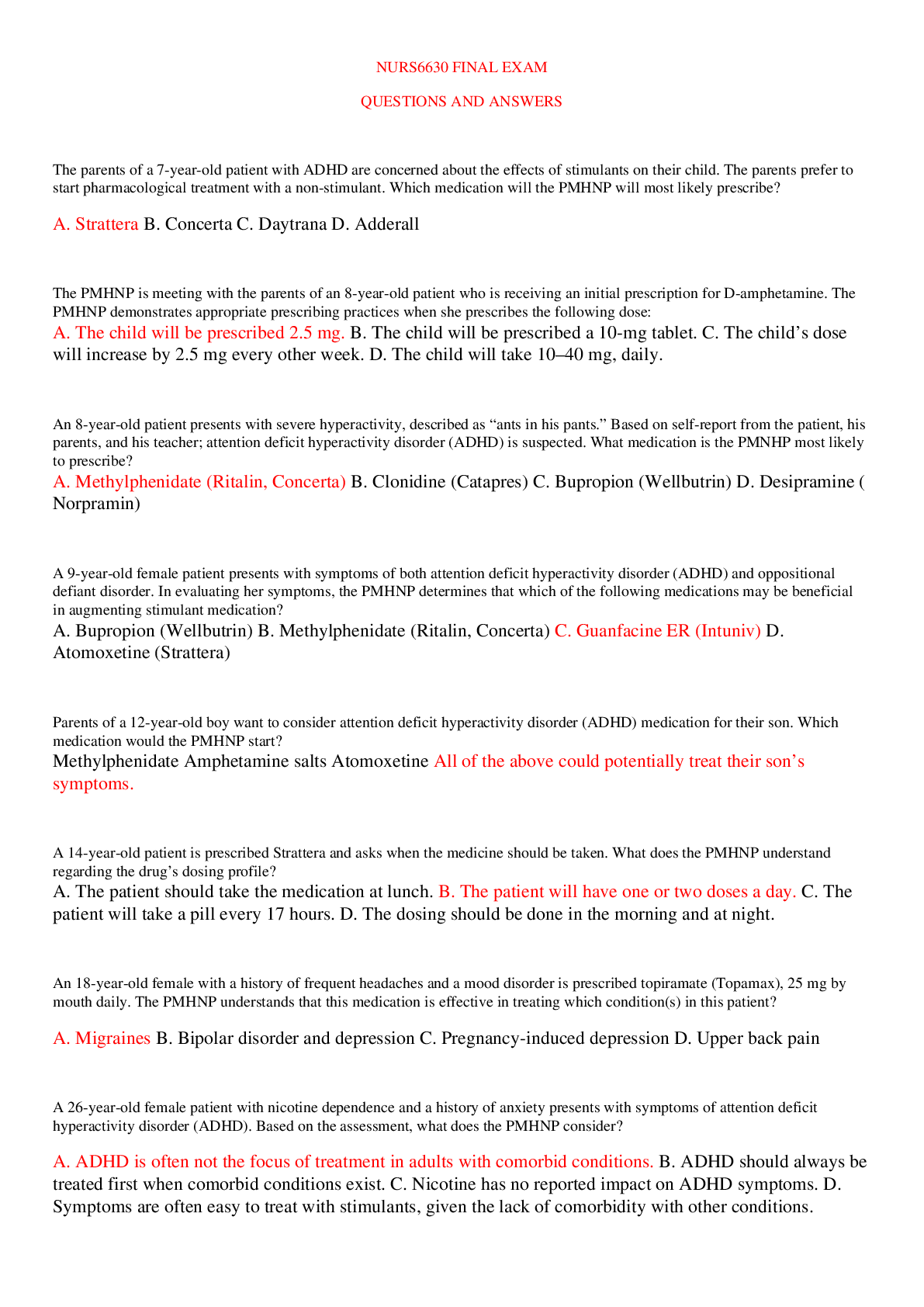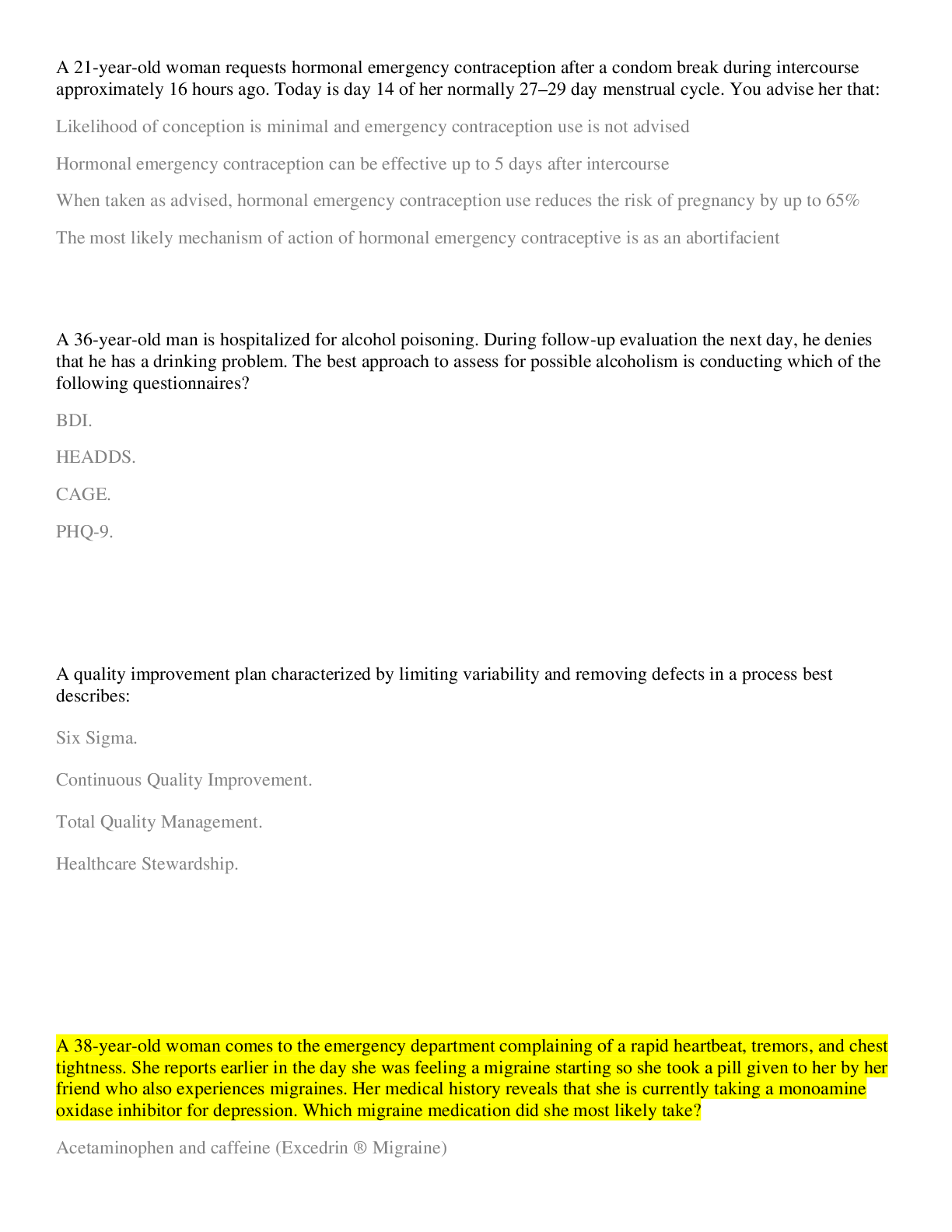*NURSING > EXAM > NURS 6551 Final Exam 2 Pediatrics(2019/2020) Complete Solution Guide, Walden University. (All)
NURS 6551 Final Exam 2 Pediatrics(2019/2020) Complete Solution Guide, Walden University.
Document Content and Description Below
NURS 6551 Final Exam 2 pediatrics • Question 1 When completing this quiz, did you comply with Walden University’s Code of Conduct including the expectations for academic integrity? ... • Question 2 Lisa has Cushing's syndrome. You would suspect her to have or to develop • Question 3 A 4-year-old female with profuse vomiting, sweating, lacrimation, and diarrhea, who seizes in the emergency room. Which of the following is the most likely etiology? • Question 4 Antibiotic therapy is one of the mainstays of treatment for which of the following causes of wheezing? • Question 5 An 18-month-old African American girl is brought to your office because she has been crying and stopped walking today. She will crawl, however. Her mom denies any injury to the child. On examination, she is crying but consolable in her mother’s arms. She has bruising and swelling just proximal to the left ankle. An x-ray reveals a spiral fracture of the tibia. At this time, you advise the mother that: • Question 6 Tracy, the mother of a 2-year-old, is concerned because her daughter walks on her toes all the time. What do you tell her? • Question 7 Vomiting in infancy has a long list of differential diagnoses. Which of the following other symptoms would mostly likely point to pyloric stenosis? • Question 8 The following clinical description best matches which genetic disorder? An institutionalized male juvenile delinquent upon close examination has severe nodulocystic acne, mild pectus excavatum, large teeth, prominent glabella, and relatively long face and fingers. His family says he has poor fine motor skills (such as penmanship), an explosive temper, and a low-normal IQ. • Question 9 Newborn R.T. has a vascular lesion that will not fade as she gets older. What is your diagnosis? • Question 10 A 6-year-old boy is left alone for 10 hours, now with hematemesis and pneumomediastinum on chest x-ray. Which of the following is the most likely etiology? • Question 11 In mild to moderate attacks of acute asthma, Albuterol should be given every 4-6 hours prn and routine medication should be • Question 12 A 2-year-old presents to your office with the following symptoms: nasal congestion and rhinorrhea for 48 hours, low-grade fever, and a harsh/barky cough that is significantly worse at night. Inspiratory stridor is present and she has clear but slightly decreased breath sounds. Which of the following treatments is best? • Question 13 A small-for-gestational-age, dysmorphic newborn infant has microcephaly and sloping forehead, cutis aplasia (missing portion of the skin and hair) of the scalp, polydactyly, microphthalmia, and omphalocele. Which of these is the most likely diagnosis? • Question 14 Which of the following physical stigmata are common in newborns with Down syndrome? • Question 15 You have a patient that you think may have intussusception. Which of the following finding may you see? • Question 16 Which of the following is true regarding the diagnosis of epiglottitis? • Question 17 An 8-month-old baby arrives to the office with his mother with a complaint of decreased left arm movement. He is a product of a normal term pregnancy, has had no medical problems, and was in good health when his mother dropped him off at the daycare center. Upper arm radiographs show a left humerus spiral fracture. Which of the following is the most appropriate next step in management? • Question 18 A 6-week-old boy, born by vaginal delivery after an uncomplicated term gestation, has experienced cough and “fast breathing” for 2 days. His mother relates that he has a 1-week history of nasal congestion and watery eye discharge, but no fever or change in appetite. He has a temperature of 99.4°F and a respiratory rate of 44 breaths/min. He has nasal congestion, clear rhinorrhea, erythematous conjunctivae bilaterally, and watery, right eye discharge. His lungs demonstrate scattered crackles without wheezes. Which of the following is the most likely pathogen? • Question 19 The parents of an 8-year-old Down Syndrome boy arrive for his annual well-child visit. He wants to participate in sports, including the Special Olympics. Until further examination can be completed, which of the following sports would you suggest as being safe? • Question 20 Of the following patients, which child should not receive a tuberculin skin test? • Question 21 A 3-week old presents to the office in January with a 1-week history of nasal congestion and occastional cough. On the night prior to the visit in infant developed a fever 102ºF rectally, was difficult to breastfeed, and had paroxysmal coughing and noisy, labored breathing. On exam, you note an ill-appearing infant who is lethergic with wheezing, tachypnea, and intercostal retractions. The infant is home with the mom at this time; however, has a sibling who is 4-years-old and is in daycare and recently had cold symptoms. If the patient has been diagnosed with RSV bronchiolitis, which of the following would be the treatment of choice? • Question 22 The peak incidence for adolescent gynecomastia occurs at age • Question 23 Which of the following statements is not true with slipped capital femoral epiphysis? • Question 24 Which of the following patients least warrents a sweat chloride test? • Question 25 Which of the following objective data are associated with significantly better long-term outcomes in children born with open spina bifida? • Question 26 Unilateral wheezing is a finding suggestive of • Question 27 Which malignancy is associated with genitourinary anomalies? • Question 28 All of the following is treatment for a child with phimosis except • Question 29 A 14-year-old has a 3-week history of fever, anorexia, and abdominal pain. What additional symptom would cause the NP to suspect Crohn's disease? • Question 30 Which of the following is not associated with congenital adrenal hyperplasia? • Question 31 Fifth disease is usually • Question 32 Which of the following is not characteristic of an apparent life-threatening event (ALTE)? • Question 33 Which of the following conditions is most responsible for developmental delays in children? • Question 34 Lyme disease is most closely associated with which of the following skin lesions? • Question 35 Jason, age 14, appears with tender discoid breast tissue enlargement (2-3 cm in diameter) beneath the areola. Your next action would be to • Question 36 Riley, a 12-year-old girl, has scaly, hyperpigmented lesions in a "Christmas tree" distribution. It is predominantly on her trunk. One lesion is on her buttock that is larger than the other, at about 4 cm in diameter. What is your diagnosis? • Question 37 Seborrhea dermatitis is common for both infants and adolescents. Which is not correct for this condition? • Question 38 The following clinical description best matches which genetic disorder? A 15-year-old girl with primary amenorrhea is noted to be well below the 5th percentile for height. She has hypertension, a low posterior hairline, prominent and low-set ears, and excessive nuchal skin. • Question 39 When a neonate is initially protected against measles, mumps, and rubella because the mother is immune, this is an example of which type of immunity? • Question 40 A 2-year-old presents with a history of wheezing and persistent cough. The father reports the child had a coughing/choking episode about a week ago that was spontaneously resolved. A few days later she began to cough and wheeze. This scenario is most consistent with • Question 41 While doing a 5-year-old well child exam, you notice two small patches of hair loss. Broken hair is present, as is erythema and scaling. On the basis of this information, which of these is the likely diagnosis? • Question 42 A 3-week-old male infant with 2 days of projectile, nonbilious vomiting and constant feeding. Which of the following is the most likely etiology? • Question 43 The most significant major contributor or contributors to asthma morbidity and mortality is/are • Question 44 Individuals with chronic adrenal insufficiency often have • Question 45 A healthy 8-month-old infant presents with diarrhea but no dehydration. What is the best advice to give to the parents? • Question 46 Anthony is a known asthmatic. He has symptoms three times a week but never more than once a day. Exacerbations affect his normal activities occasionally. He awakens with cough three to four times a month. You classify his asthma as • Question 47 A 9-year-old is diagnosed with dyspepsia without hematemesis, melena, or occult blood. The most appropriate next step is • Question 48 Which of the following is not a sign or symptom of congenital hypothyroidism? • Question 49 A 9-month-old has been diagnosed with gastroenteritis. He attends a daycare facility. What is the likely cause of the illness? • Question 50 A 7-year-old presents with abrupt fever, stridor, drooling, and hyperextension of the neck. You examine the nose and throat and notice one tonsil is enlarged and there is marked erythema of the pharynx with uvular deviation. Which is most appropriate? • Question 51 A 16-year-old presents with pharyngitis, cough, and high fever. Her chest x-ray reveals bilateral pulmonary infiltrates. Her white blood cell count is normal and the neutrophil count is normal. The most likely etiology is • Question 52 You see a 7-year-old with a positive stool culture for Salmonella enteriditis. The appropriate therapy for a non-dehydrated child is • Question 53 The most common cause of primary amenorrhea is • Question 54 A 3-year-old presents with macrocephaly, developmental delay, coarse facial features, large tounge, kyphosis, hip dislocation, tonsillar and adenoidal hypertrophy, and hepatomegaly. She is receiving early intervention services without improvement. What is the best next step? • Question 55 When Jason, age 12, slid into homeplate while playing baseball, he injured his ankle. You are trying to differentiate between a strain and a sprain. You know that a sprain • Question 56 Hypercholesterolemia in children older than 2 is defined as a total cholesterol at or above • Question 57 The most accurate way to determine the degree of dehydration in a vomiting child is to assess • Question 58 Primary dysmenorrhea is due to • Question 59 The most common presentation of Hirschprung disease is which of the following? • Question 60 A small-for-gestational-age infant is born to a 35-year-old woman. He has low-set and malformed ears, microcephaly, rocker-bottom feet, inguinal hernias, cleft lip/palate, and micrognathia. Chromosomal analysis is likely to reveal which of the following? • Question 61 A 3-week old presents to the office in January with a 1-week history of nasal congestion and occasional cough. On the night prior to the visit in infant developed a fever 102ºF rectally, was difficult to breastfeed, and had paroxysmal coughing and noisy, labored breathing. On exam, you note an ill-appearing infant who is lethargic with wheezing, tachypnea, and intercostal retractions. The infant is home with the mom at this time; however, has a sibling who is 4-years-old and is in daycare and recently had cold symptoms. Based on the clinical presentations, what is the most likely cause of the infant’s illness? • Question 62 What does shift to the left mean in a white blood count? • Question 63 A 10-year-old male presents with a fever of 102ºF and complaints of leg pains. His mother reports that he had an upper respiratory infecion with a sore throat about 2 weeks ago. No treatment was needed. On examination, he has tender and swollen knees bilaterally. His heart rate is 125 bpm and a blowing systolic murmur is heard at the apex. No murmur was noted at in the chart. The mostly diagnosis is: • Question 64 A 2-year-old girl has increased work of breathing. Her father notes she had cough and subjective fever over the past 3 days. She has been complaining that her “belly hurts” and has experienced one episode of post-tussive emesis but no diarrhea. Her immunizations are current, and she is otherwise healthy. Her temperature is 102°F. She is somnolent but easily aroused. Respirations are 28 breaths/min, and her examination is remarkable for decreased breath sounds at the left base posteriorly with prominent crackles. Which of the following acute interventions is the LEAST likely to assist in the diagnosis? • Question 65 Dave, age 17, has gynecomastia. You should also assess him for • Question 66 An adolescent female presents with a 2-day history of increasing lower abdominal pain. She has mild vomiting and anorexia and fevers to 101F. She is unable to defecate but has an urge to do so. CBC reveals a slightly elevated WBC of 14,000, but is otherwise normal. Serum electrolytes are normal. The next step is • Question 67 The classic radiographic finding of croup is • Question 68 An 8-month-old female infant with bilious vomiting, constant abdominal pain for 12 hours and upper GI study showing beaklike appearance of contrast. Which of the following is the most likely etiology? • Question 69 Jesse, age 5, has a diagnosis of encopresis. After the diagnosis, what would be your next action? • Question 70 The peak incidence of osteosarcoma is • Question 71 Ben has been diagnosed with folliculitis, an inflammatory condition involving the pilosebaceous follicle. What is the most common cause of this condition? • Question 72 Jennifer, age 16, is an active cheerleader who just developed type 1 diabetes. She is worried that she will not fit in with her friends anymore because she does not think she can have all the same snacks they have. How do you respond? • Question 73 Which of the following is a characteristic physical sign of fragile X syndrome in adolescent males? • Question 74 Which of the following is not true of insect stings from bees, wasps, and fire ants? • Question 75 Tommy has bloody diarrhea. His family eats fast-food four to five times each week. Which organism may have caused the diarrhea? • Question 76 Prophylactic penicillin should be started in children with sickle cell anemia by • Question 77 Which chromosomal abnormality is associated with short stature in girls? • Question 78 A child has developed her second perirectal abscess in 6 months. She should be evaluated for which of the following conditions? • Question 79 A 14-month-old child has lower extremity bowing, a waddling gait, genu varum, and is at the 5th percentile for height. Laboratory data include low-normal serum calcium, moderately low serum phosphate, and elevated serum alkaline phosphatase levels, hyperphosphaturia, and normal parathyroid levels. Which of the following is the most likely diagnosis? • Question 80 A previously healthy male has a 3-month history of increasing headaches, blurred vision, and personality changes. Previously he admitted to marijuana experimentation more than 1 year ago. On examination he is a healthy, athletic-appearing 17-year-old with decreased extraocular range of motion and left eye visual acuity. Which of the following is the best next step in his management? • Question 81 Which of the following is true regarding innocent murmurs? • Question 82 Which fo the following foods would be most appropriate for a child with celiac disease? • Question 83 A common presenting symptom of inflammatory bowel disease is • Question 84 You see a 7-year-old boy a day after he was bitten by his pet dog. According to the mother, the dog bit the child after he snuck up on the dog and grabbed his tail. The dog has had all its vaccinations, including rabies. The child has had no fever, has full movement of the injured limb, and has no sign of neurologic or vascular injury. The wound is on the child’s forearm, is not deep, and is not bleeding, but has developed about 2 cm of erythema surrounding the site. Which of the following is the most appropriate treatment? • Question 85 Whitney is a 2-year-old female with dysuria. She has a fever of 102.4 and is nontoxic. She has no prior history of UTI. Urine dipstick reveals 1+ leukocyte esterase, 2+ nitrates, 1+ non-hemolyzed blood, pH of 6.0, and specific gravity 1.025. Her vulvovaginal area is slightly red with no discharge. Which of the following treatments is recommended. • Question 86 A 2-year-old boy is brought in with fever and poor feeding. He started getting sick yesterday and has worsened significantly today. He has had no recent illnesses or injuries, and no known ill contacts. On examination, his temperature is 101°F, he is tachycardic, and he appears ill. He is laying on his back with his left leg flexed and abducted at the hip. The HEENT examination is normal, heart is tachycardic but regular, and the lungs are clear. The abdomen is nontender and has normal bowel sounds. He screams in pain when you move his left leg from its resting position. Blood work reveals an elevated WBC count of 15,000 mm3 and an ERS or 45 mm/h. An x-ray of his left hip shows a widened joint space but no fractures. What is your next step at this point? • Question 87 A 14-year-old girl from another state was followed for 7 years for a history of insulin-dependent diabetes mellitus. Her hemoglobin A1C is 14.9%. This laboratory test indicates which of the following? • Question 88 Which of the following is the primary diagnostic tool used in the evaluation of seizure disorders? • Question 89 Robert, your 15-year-old male patient, is here today for a well visit. He is tall in stature and has increased arm span, laxity of joints, pectus excavatum, and an abnormal echocardiogram. Which of the following diagnosis would you suspect Robert as having? • Question 90 In children who have not received antibiotics in the past month, which antibiotic is recommended by the Centers for Disease Control and Prevention for the management of acute bacterial respiratory infection? • Question 91 Which of the following is a measure of childhood intelligence? • Question 92 John, age 12, injured his spinal cord by diving into a shallow lake. He is in a wheelchair but can self-transfer. He can use his shoulder and extend his wrist, but has no finger control. At what level of the spinal cord was the damage? • Question 93 You are examining Beth, age 9 months, and note a palpable right supraclavicular node. You know that this finding is suspicious for • Question 94 Maddie, age 2, had a complete blood count (CBC) drawn at her last visit. It indicates that she has a microcytic hypochromic anemia. What should you do now at this visit? • Question 95 The most common central nervous system side effect of mumps in children is • Question 96 Michael, age 16, sprained his ankle while playing ice hockey. He is confused as to whether to apply heat or cold. What do you tell him? • Question 97 The organism that causes hand, foot, mouth syndrome is what virus? • Question 98 A 7-month-old female was brought by her mother to an outpatient clinical because of a 2-day history of fever, copious nasal secretions, and wheezing. The mother volunteered that the baby has been healthy and has not had these symptoms in the past. The infant’s temperature is noted to be 100.7°F, her respiratory rate is 50 breaths/min, and her pulse oximetry is 95% on room air. Physical examination reveals no signs of dehydration, but wheezing is hear on lung auscultation. The infant shows no improvement after three treatments with nebulized albuterol. Which of the following is recommended treatment? • Question 99 A healthy, thriving 4-year-old male has had sudden episodes of drawing his knees to his chest and crying like he is in acute pain for the last 5 hours. These episodes are separated by quiet times when he appears normal and comfortable. He is not vomiting and has not had a bowel movement today. What is the most likely diagnosis. • Question 100 An 11-month-old male with intermittent bouts of crying and nonbilious vomiting, has a history of Meckel diverticulum. A small elongated mass is felt on the right side of his abdomen. Which of the following is the most likely etiology? • Question 101 The diet of a 3-year-old with cystic fibrosis should be supplemented with which of the following? [Show More]
Last updated: 1 year ago
Preview 1 out of 19 pages
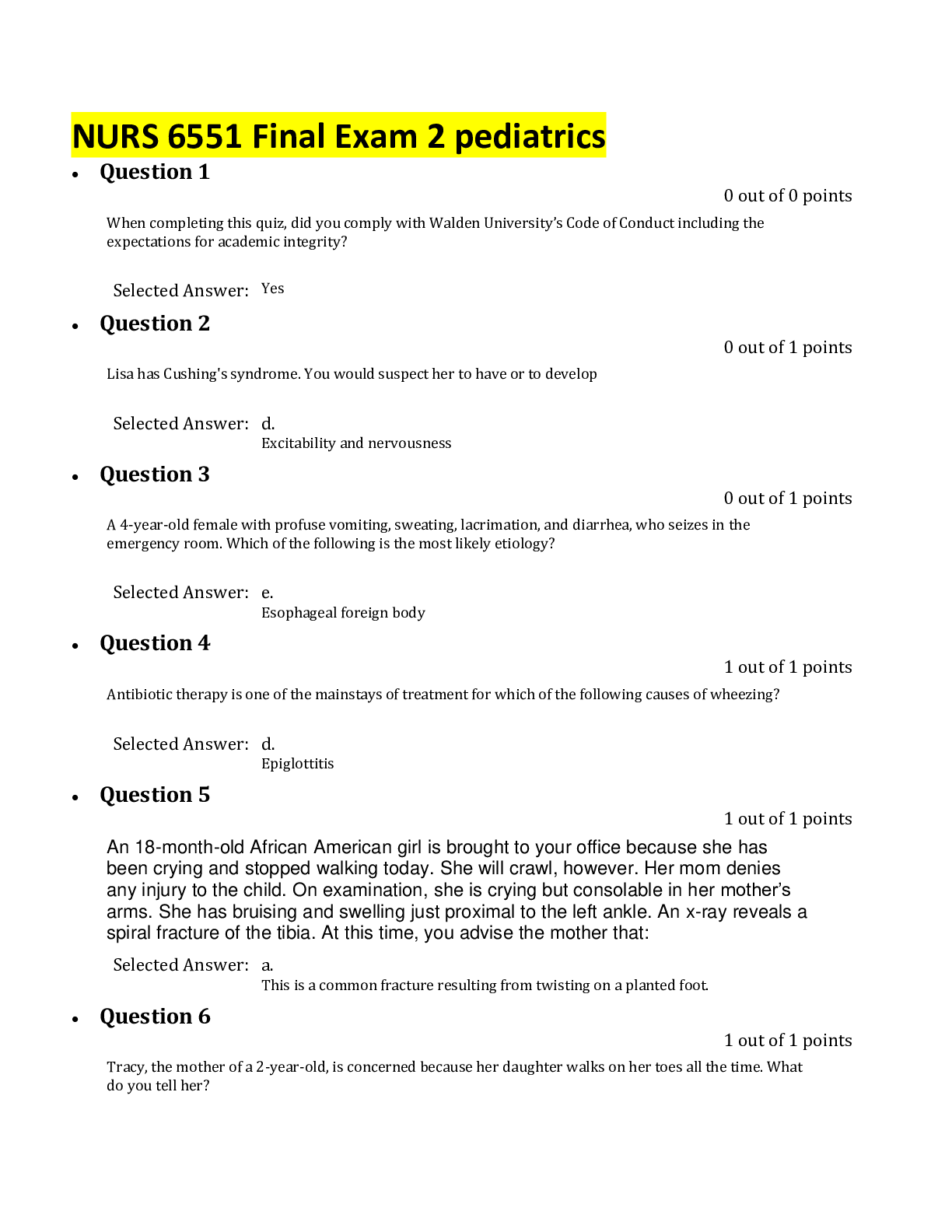
Reviews( 0 )
Document information
Connected school, study & course
About the document
Uploaded On
May 16, 2020
Number of pages
19
Written in
Additional information
This document has been written for:
Uploaded
May 16, 2020
Downloads
0
Views
68

